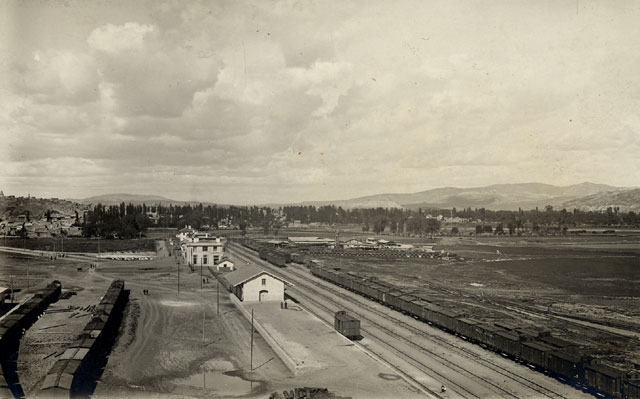
| Sivas |
| HOME - The Azarians |
| Abraham Azarian and Lucy Arevian/Hagopian Abraham Azarian was born in Sivas, Turkey in 1865 Lucy Arivian/Hagopian was born in the village of Pirkinik in the Vilayet of Sivas in 1875/76. See Pirkinik
|
| Images Old and New Of Sivas |
 |
| Postcard collection of Maggie Land Blanck |
| Sivas Train Station
|
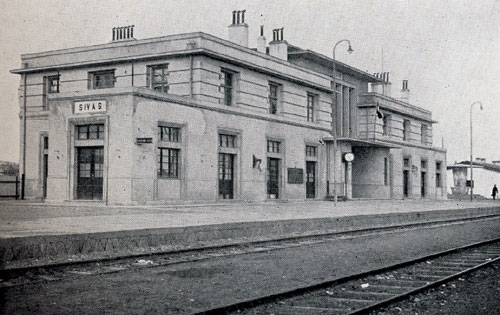 |
Railroad Station The railroad came to Sivas in 1930. |
|
Allah Dethroned, a Journey Through Modern Turkey Lilo Linke, published in 1937.
| |
| | |
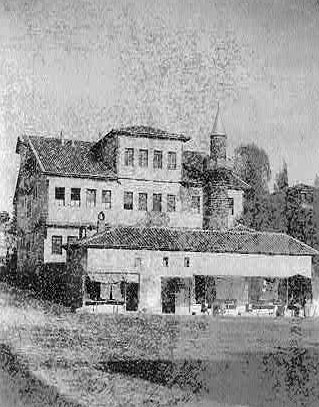 | Imperial military middle school Sivas |
| Library of Congress, 2012 Title: [Imperial military middle school Sivas Mekteb-i Rusdiye-yi Askeri-yi] Date Created/Published: [between 1880 and 1893] Medium: 1 photographic print : albumen. Reproduction Number: LC-USZ62-80832 (b&w film copy neg.) | |
| | |
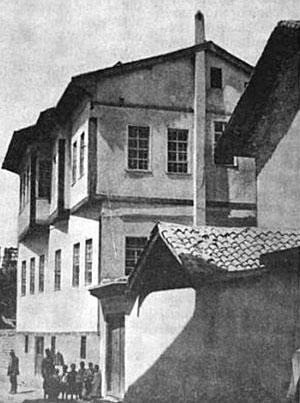
Missionary Herald at Home and Abroad vol 104. The Sights of Sivas. Sivas Normal School | |
| | |
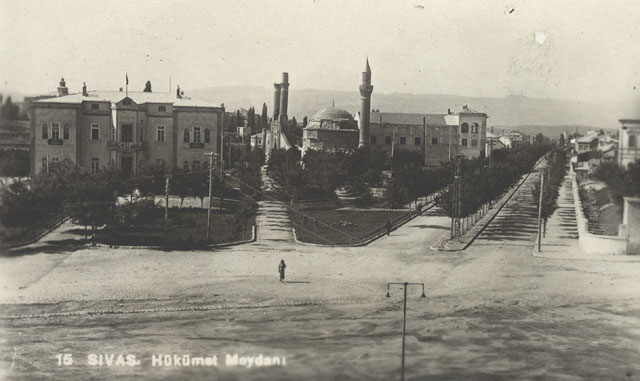 | |
| Postcard collection of Maggie Land Blanck | |
| Sivas Hokumet (Government) Meydani (Square), date unknown The buildings on the right and left are no longer standing. The domed building in the center of the images is the Kale Camii (Mosque) - built in 1580. The building with the double minarets is the Cifte Minareli Medrese (See below.). The Street on the right is Inonu Boulevard. This is the main square in Sivas from which radiate the major roads of the city. Behind the viewer and to the left outside the picture are the Statehouse building and the Sivas Ataturk Congress and Ethnography Museum, shown in the following image. | |
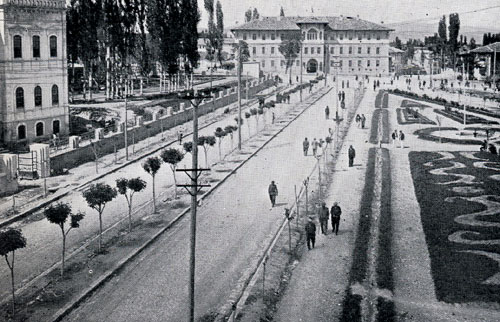 | |
|
Allah Dethroned, a Journey Through Modern Turkey Lilo Linke, published in 1937. In the middle of the image is the Inonu Boulevard with the Statehouse built in 1884 at the end of it. The first two floors of the Statehouse were cut stone and the top floor (added in 1913) was wood. Partly visible on the left is the Sivas Ataturk Congress, which was built in 1892 as a high school. | |
| | |
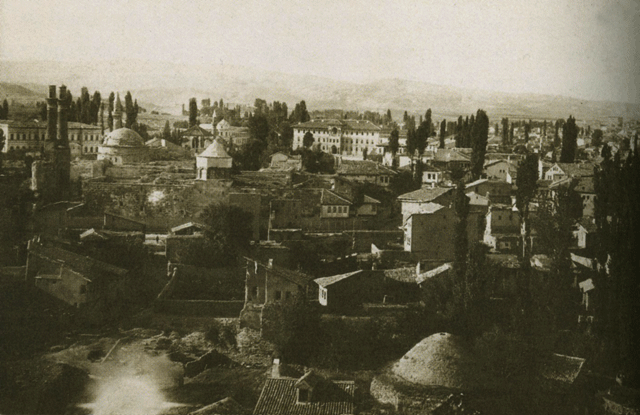 | |
| Sivas 1877, edited by Arsen Yarman 2008, Arsen Yarman arsivi The Statehouse and Sivas Ataturk Congress buildings are to the back middle and the back left. The double minarets of the Cifte Minerali Medessi are visible in front of the Congress building. The dome of the Kale Camii is to the right of the twin minarets. Most of the rest of the buildings have been torn down. | |
| | |
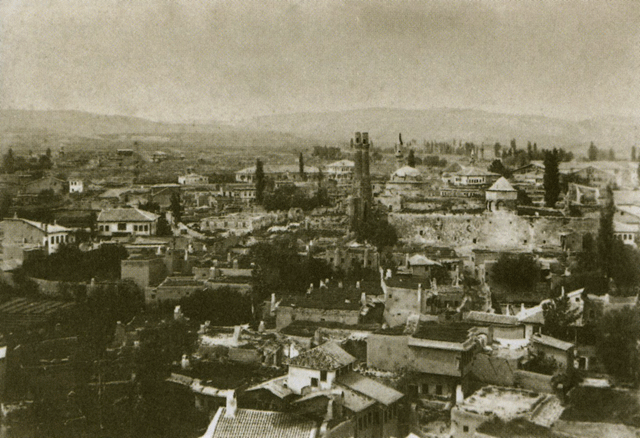 | |
| Sivas 1877, edited by Arsen Yarman, 2008, Arsen Yarman arsivi
This image is a shift to the left of the previous image. The twin minarets of the Cifte Minerali are no more centered in the picture. | |
| | |
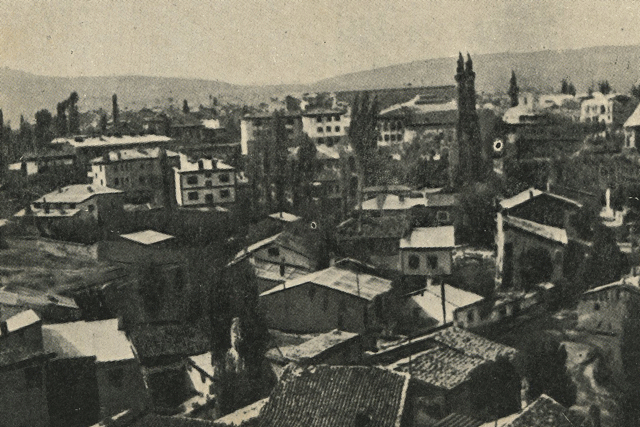 | |
| Postcard collection of Maggie Land Blanck Sivas: Umumi Gorunus | |
| | |
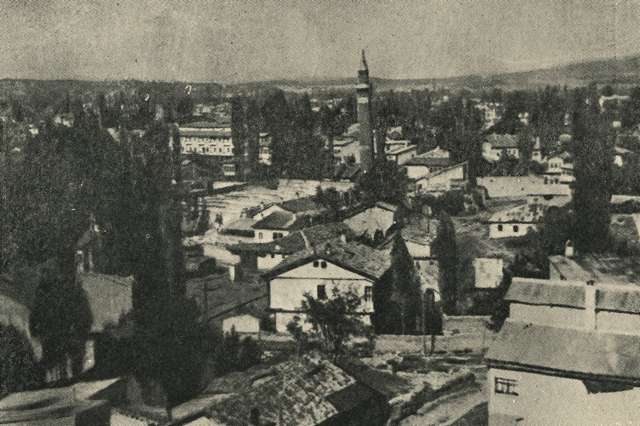 | |
| Postcard collection of Maggie Land Blanck Sivas: Umumi Gorunus | |
| | |
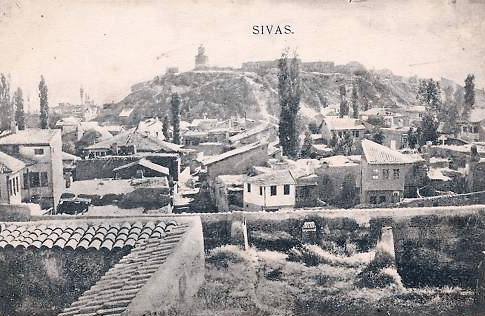 | |
| Postcard collection of Maggie Land Blanck | |
| | |
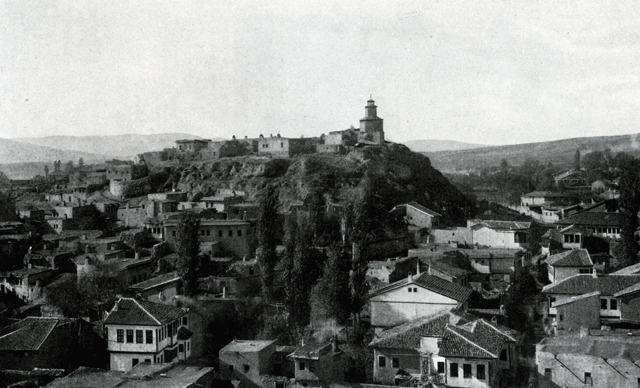 | |
| Collection of Maggie Land Blanck, January 2012
A VIEW OF SIVAS, SHOWING THE HILL FORMERLY CROWNED BY A CITADEL This images was cut from National Geographical Vol 43, 1923. Photograph by Encababian. The Encababian Freres were an Armenian family of photographers from Sivas, who according to several online accounts were allowed to stay in Sivas after the deportations of 1915. In May 2012 Deborah Surabian wrote: Karekin Encababian and his brother's studio name was "Encababian Freres" in Sivas. Immediately after my mother, Knar, was born on November 22, 1922, the family left everything behind in Sivas and for safety reasons went by caravan to the city of Constantinople as it was still very dangerous for Armenians at that time due to the genocide and it was more dangerous in the outlying areas. They thought they would be safer in the city. In June 2012 she added: My grandfather and his brother were thrown in prison. However, it is true that they were eventually released and that they were spared as they were held in high regard for their skills and the Turks were persuaded that they would need professional photographers. We were told this story over and over growing up. | |
| | |
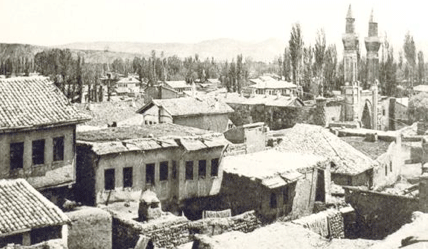 | |
| A view of the area that now forms part of the Govermment Square. | |
| | |
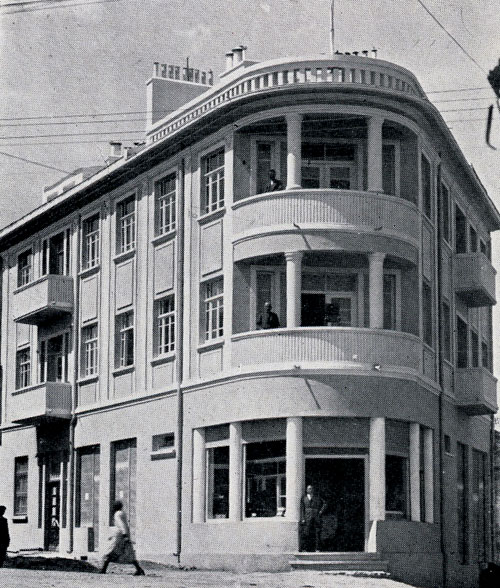 |
"Modern Hotel", Sivas
|
|
Allah Dethroned, a Journey Through Modern Turkey Lilo Linke, published in 1937.
| |
| | |
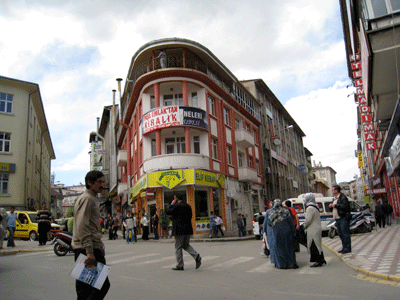 |
Ataturk Cadessi Elif Kebap-Lahmacun, May 2008 Tom and I had lahmacun here in May 2008. |
|
Photo Maggie Land Blanck, May 2008
| |
| | |
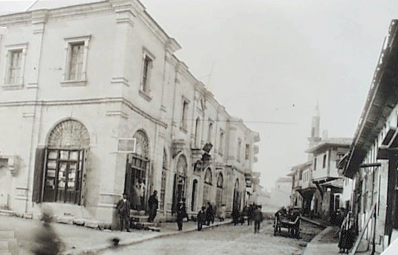 | |
| The Ziya Bey Library All of the buildings on the right side of the image are gone. | |
| | |
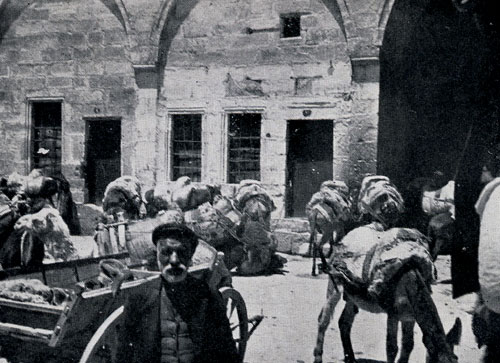 |
"An Old Inn", Sivas
|
|
Allah Dethroned, a Journey Through Modern Turkey Lilo Linke, published in 1937.
This is a typical Caravanserai (or Khan). The animals were stabled on the bottom floor and
there were rooms for people on the top floor.
| |
| | |
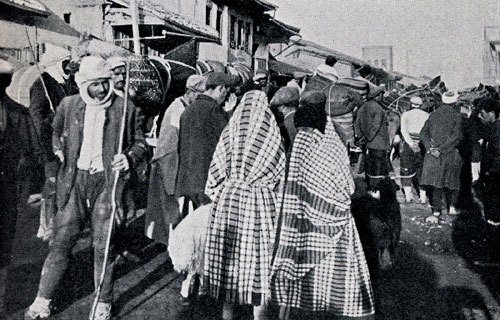 |
Buyers in the Market Place, Sivas
|
|
Allah Dethroned, a Journey Through Modern Turkey Lilo Linke, published in 1937.
| |
| | |
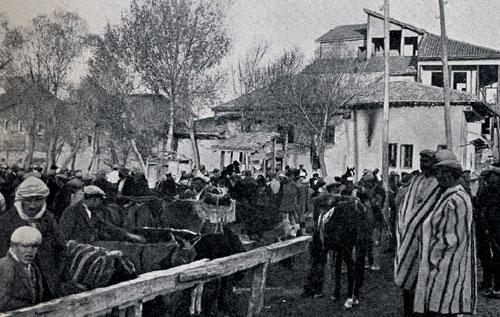 |
Market Place, Sivas
|
|
Allah Dethroned, a Journey Through Modern Turkey Lilo Linke, published in 1937.
| |
| | |
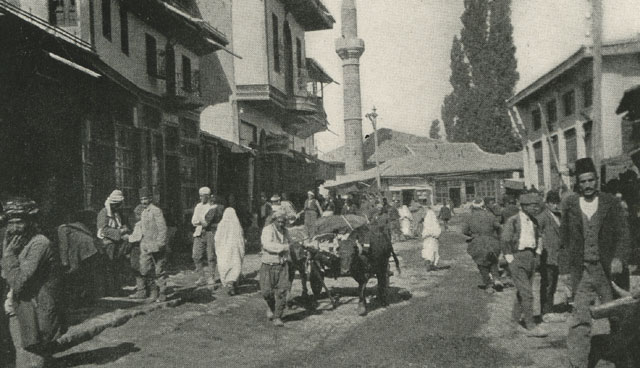 | |
| National Geographic 1924, Crossing Asia Minor, The Country Of The New Turkish Republic by Major Robert Whitney Imbrie "A Street in Sivas." | |
| | |
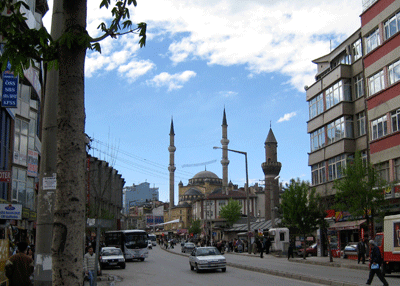 | |
| Photo Maggie Land Blanck, May 2008
The lone minaret which is situated in front of and to the right of the yellow mosque
in the center of the image
is the minaret on the Ulu Camii (Mosque). This could be the minaret in the center of the image "A Street
in Sivas". In any event there are clear differences in the streets of Sivas between 1924 and 2008.
Ulu Camii built in 1196/97 is one of the oldest mosques in Sivas. The minaret was built in 1213. | |
| | |
|
Seljuk Sivas
|
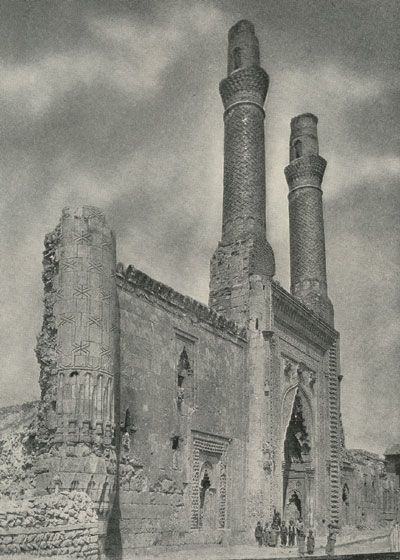 | Cifte Minareli Medrese (Seminary of the Twin Minarets, 1271), built under the "instructions" of the Ilkhanid vizier Sahip Semseddin Mehmet Cuveyni (Sivas, Ministry of Culture and Tourism Guide to Sivas). |
| National Geographic 1924, Crossing Asia Minor, The Country Of The New Turkish Republic by Major Robert Whitney Imbrie | |
|
"A Seljuk Mosque With Fallen Minarets in Sivas" "The colleges and mosques are the most pretentious and interesting buildings in Sivas, one of the largest and most important cities in the interior of Asia Minor. Several of the mosques are now merely fragments, but their warm-tinted yellow stone and occasional brickwork, their deep doorways, with elaborately carved panels, their sky-blue tiles and tapering minarets, help to keep up the tradition al reputation and atmosphere of the East." | |
| | |
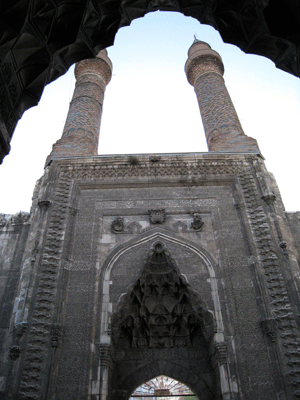
|
Cifte Minareli Medesse, May 2008
|
| Photo Maggie Blanck, May 2008 | |
| | |
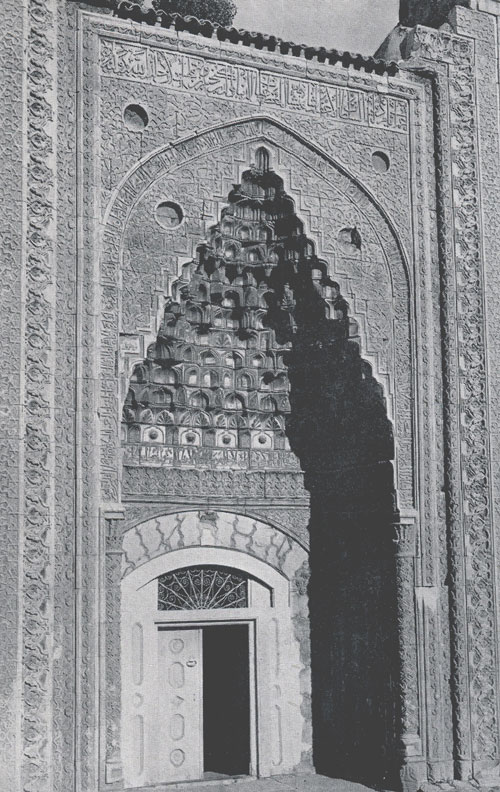 |
Mosque Doorway, Sivas
|
|
Allah Dethroned, a Journey Through Modern Turkey Lilo Linke, published in 1937.
| |
| | |
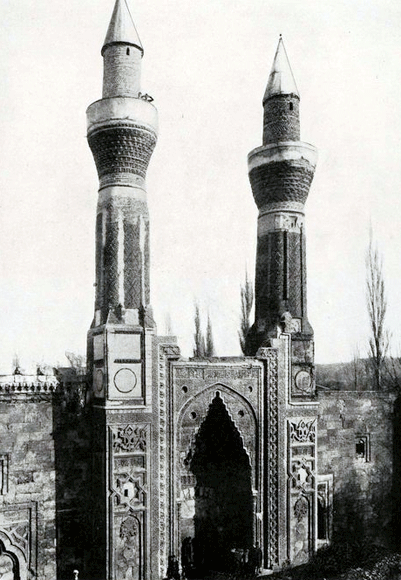 | |
Collection of Maggie Land Blanck, January 2012
TOWERING MINARETS, BRICK-RED AND FRETTED OVER WITH DESIGNS IN BLUE TILING : SIVAS Photo by Encababian - See above Image from National Geographic 1923. | |
| | |
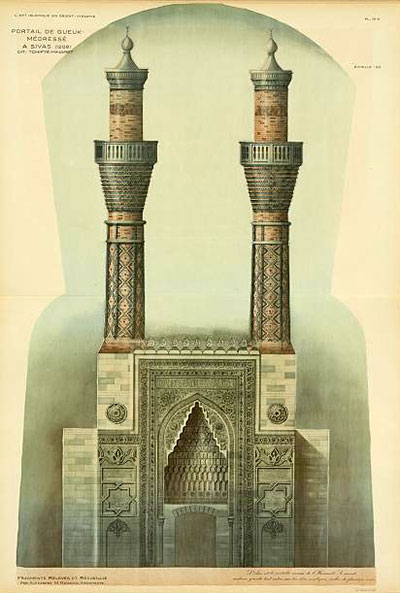 | |
|
Library of Congress, Washington, D.C., 2012
Title: Portail de Gueuk-medresse a Sivas (1208). Dit: Tchifte-minaret / Fragments releves et recueillis par
Alexandre M. Raymond, Architecte.
Title Translation: Portal of the Gok medrese at Sivas (1208). Called the Tchifte [i.e. Cifte] minaret Creator(s): Raymond, Alexandre M., artist Date Created/Published: [Pera, Constantinople: Librairie Raymond, 1924] Summary: Lithograph showing the front facade of the Cifte Minaret Madrasa (Gok Medresse) with door and two minarets, Sivas, Turkey. Reproduction Number: LC-DIG-ppmsca-22255 (digital file from original item)
| |
| | |
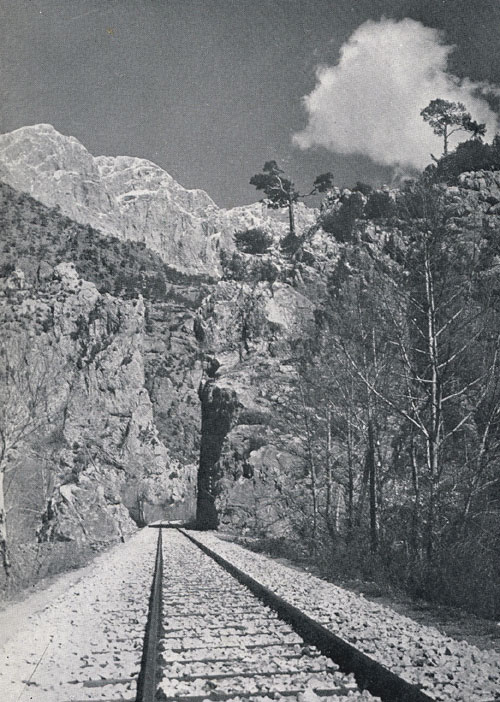 |
Central Anatolia
|
|
Allah Dethroned, a Journey Through Modern Turkey Lilo Linke, published in 1937.
| |
| | |
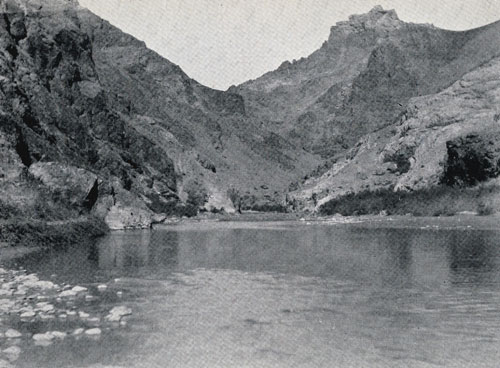 |
In the Country East of Sivas
|
|
Allah Dethroned, a Journey Through Modern Turkey Lilo Linke, published in 1937.
| |
| | |
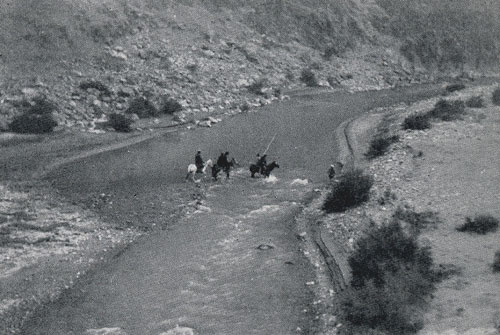 | The Old Way |
|
The title that Ms. Linke
gave this photo refers to the fact that by 1930 Anatolia could be crossed by railway with bridges that spanned the
rivers. This photo and the previous two photos give some idea of the harshness of the Anatolian terrain. Abraham and Lucy and/or their families left Sivas before the advent of the railroads. I do not know the route they took to Constantinople. The two possibilities are: overland all the way, or overland from Sivas to Samsun on the coast of the Black Sea and then by boat from Samsun. Either way it required some overland travel. In addition to overcoming the difficulties of the terrain the traveler had to beware of brigands and murderers. Rev. L. Bartlctt and wife, of Ceaarea, and Dr. Davis and wife, with Miss Laura Chamberlain, of Sivas, were robbed while journeying from Broossa to Cesarea in 1879. Rev. J. Leonard and wife, with Miss Eliza Fuleher, of Marsowau, were robbed and Mr. Leonard beaten by Circassians while journeying at a few hours' distance from their home in 1879. Rev. J. W. Parsons and his servant were robbed and murdered on the mountains near Baghchejuk* in 1880. Rev. H. Perry was robbed while journeying east of Sivas in 1881. Rev. H. N. Barnum was robbed on his journey from Harpoot to Sivas in the spring of 1881.Theses pictures also give some idea of the difficulty encountered by the women and children on the forced marches in 1915. *In May 2012 Deborah Surabian wrote: I was also very excited to see reference to Baghchejuk as my mother's family had a "summer home" there and up until now I have never been able to find any information about this area as I never had the correct spelling. |
| |
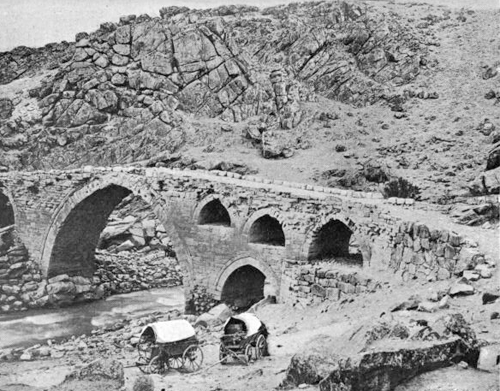 |
Bridge on the road between Sivas and Ersinjan A Ride Through Western Asia |
|
Book collection of Maggie Land Blanck In April 2015 Geoff Tassell wrote to ask if I know where the bridge was located. This sent me on a hunt and I think I found it. There is a current picture of the bridge at Old bridge near Handere (Divrigi) Eastern Turkey: An Architectural & Archaeological Survey, Volume II by T. A. Sinclair, 1989, says in Ottoman times the main road between Sivas and Ersinjan (Erzincan) was through the upper Kizil Irmak basin over a high pass at Karabal. The road then lead to Divrigi. "At the first stage from Divrigi was the han at Handere, where there is also a bridge over the Morcinge Cay."More images on flickr
Google map showing approximate location of the Handere bridge. The ancient route was from Sivas south to Kangal and then east passing Divrigi and onto Erzincan.The bridge dates from the XIII century. It is on the Mircinge River 1 km south of Handere Village, about 201 Km. from Sivas.
Red "x" marks the location of the bridge near the village of Handere. Go to Handere hani To see a video of the Mircing Han, an old caravansary near Handere.
| |
| | |
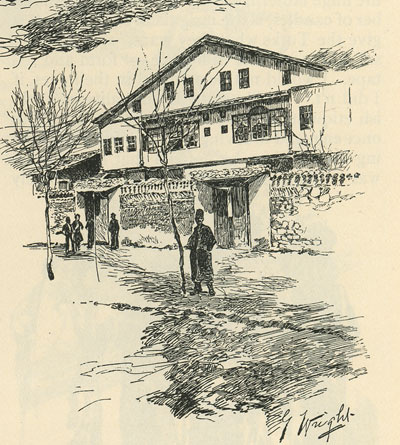 |
House of the American Consul in Sivas Across Asia on a Bicycle, Century Magazine, May 1894. |
| Periodical collection of Maggie Land Blanck | |
| | |
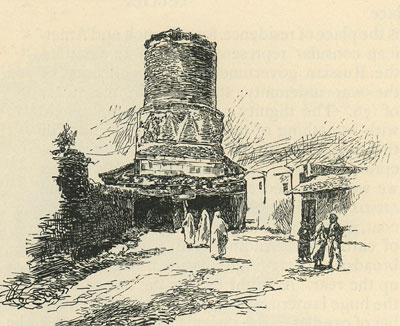 |
The "Flirting Tower" in Sivas Across Asia on a Bicycle, Century Magazine, May 1894. No information was provided about the "Flirting Tower" |
| Periodical collection of Maggie Land Blanck | |
| | |
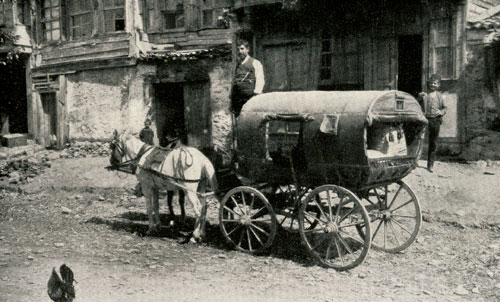 | |
| Periodical collection of Maggie Land Blanck | |
| National Geographic May 1915 "Theses springless carts are the chief means of conveyance throughout Asia Minor". This type of cart was called an araba and was the main from of wheeled transportation in Anatolia. | |
| | |
| Pictures from the National Geographic 1924, Crossing Asia Minor, The Country Of The New Turkish Republic by Major Robert Whitney Imbrie |
| |
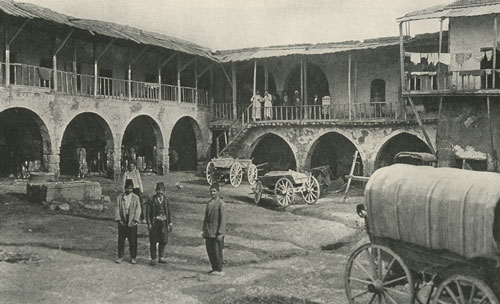 | The Khan at Tarsus |
| | |
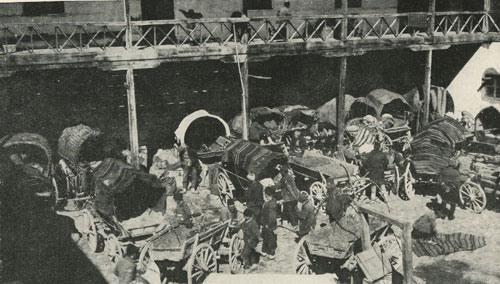 | The Interior of an Asia Minor Khan |
| | |
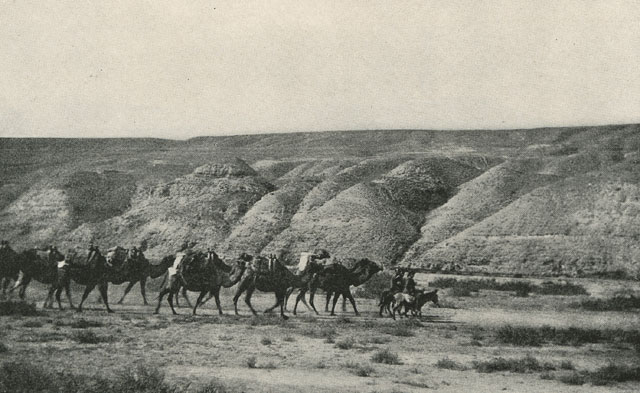 | |
| "Through Sivas runs the Great Road of Asiatic Turkey, the road over which, since history's dawn, Have passed the caravans from Bagdad to Constantinople, a road now fallen into disrepair, but still enormously important as a trade route from the Black Sea coast to the interior. The camels nearly always tied head to tail and led by a diminutive donkey, grunt along with a supercilious sneer upon their lips." | |
| | |
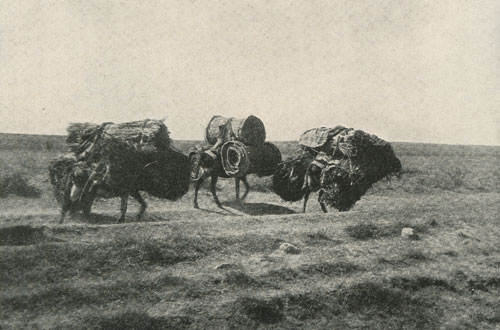 | Freight Transport in Asia Minor | ||
|
Armenians in the village of Pirkinik were reputed to be muleteers who moved merchandise
across Anatolia. See Pirkinik and
Armenians
| | ||
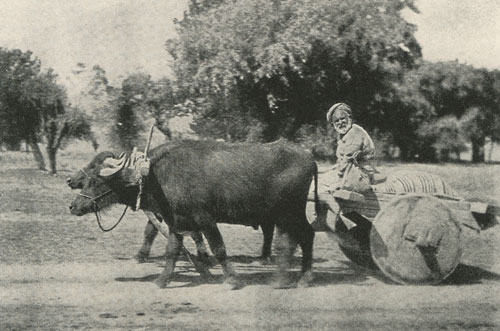 | "One of the Disk-Wheel Carts of Anatolia. Such a vehicle, with its buffalo team, travels at the rate of a mile and a half an hour." |
| | |
|
A snapshot of Sivas in 1891
The following information and listed given in the Annuaire oriental of 1891. Sivas (l'ancienne Sebaste), (Chef-lieu du Vilayer), en armenien Sepastia ancienne capital du Royaume du Pont, 39,369 habitants, dont 23,619 musumans, 14,439 armeniens, 725 grecs, 362 catholiques, et 225 protestants. [Sivas (ancient Sebaste), (Capital of Vilayet) in Armenian Sepastia ancient capital of the Kingdom of Pontus, 39.369 inhabitants, 23.619 Muslims, 14.439 Armenians, 725 Greeks, 362 Catholics and 225 Protestants. La ville est situee dans une position riante, au milieu d'une grande plaine, avec un chateau-fort, type moyen-age. La position central de Sivas dans l'Asie-Mineure est tres-importante, si l'o- considere qu'elle fraie la route du plateau de l'Anatolie
L'Halys, le plus grand fleuve de l'Anatolie, arrose Sivas, et rend tres fertile sc- territoire.
Malheureusement, les produits de agridulture, en raison de la cher des frais de transport, ne sont pas
multiplies dans la mesure dont le sol est su- ceptibel de produire. Une tonne de ble, rendue de Sivas,
a un port de la mer Noire, coulte de 40 a 50 francs, tandis que le prix net de la marchandise ets -- 10
francs a peine.
[The city is situated in a pleasant position in the midst of a great plain, with a fortified castle of the middle ages.
[The location of Sivas in central Asia Minor is very important
on the routes of the Anatolian plain.]
The Halys, the largest river in anatolia flows through Sivas and makes the territory
very fertile. Unfortunately, agricultural products, due to high transportation costs,
are not raised to the extent that the soil would allow. A ton of wheat, grown in Sivas,
at a port on the Black Sea brings 40 to 50 francs ...........
The population of the vilayet is large but there is much misery, thousands of emigrants leave each year for other provinces or the capital in its environments.] Climat froid, sources d'eaux chaudes et tiedes dont les plus importantes so-celles de Sidjak Tchermique et de Soghouk Tchermique.- Ruines des mosque et des tours du temps de Seldjoucides. - 2 prison pouvant contenir 800 prisoniers des deux sexes. 2 hopitaux pour les detenus, 1 hopital civil. - 1 Palais du gouverneur d'une jolie construction, 1 paliais de justice 1 caserne [Cold climate, hot springs and tepid, the most important ---- Sidjak Tchermique Soghouk Tchermique. - Ruins of the mosque and the towers of the time of Seljuks. - 2 jail for 800 prisoners of both sexes, Two hospitals for prisoners, a civilian hospital. - A Governor's Palace a beautiful building, a justice Paliais, a barracks] Industrie - Bas en laine renommes, tapis, (Kilim), armes, chaises mecaniques, t-- les indigenes en coton et soie, lin et laine. [ Woolen stockings, renowned carpet (Kilim ), weapons, mechanical chairs, t - the indigenous cotton and silk, linen and wool.] Importation et commerce: manifactures, coton, cotonnades, toile imprimee, draperies, soieries, fez, horlogerie, cafe, the, sucre, quincailleries, denrees, coloniales bougies, savon, huile, petrole, cuirs, peaux ouvrees, fer, etain, zinc, et. [manifactures, cotton, cotton fabric, printed fabric, draperies, silks, fez, clocks, coffee, tea, sugar, hardware, wares, colonial candles, soap, oil, petroleum, leather, skins worked, iron, tin, zinc, etc.] Exportation: ble, orge, pommes de terre, farines, laine, peaux de chevre, de mouton, et de boeuf, tiftik (mohair), opium, djehri (a berry used in dying), kitre ( another dying plant Kitre), bas en laine, toile indigene (lire), etoffes en laine dite Gurun, chales de Gurun, tapis, beurre, cire, cuivre, etc. etc. [Export: wheat, barley, potatoes, flour, wool, goat skins, sheep, and beef, tiftik, opium, djehri, kitre, woolen stockings, canvas native (read), wool fabrics called Gurun, shawls of Gurun, carpets, butter, wax, copper, etc.. etc..] La ville contient huit ecoles armeniennes de garcons frequentees par 1,042 garcon; 5 de filles frequentees par 540 filles; elles sont administrees par la Societe Sinekerimian. Une ecole grecque frequentee par 20 garcons et 13 filles; deus elcoles protestantes frequentees par 143 garcons et 83 filles. Une ecole dirigee par les PP. Jesuites, frequentes par 58 eleves. [The city has eight schools of Armenian Boys frequented by 1.042 boys, 5 girls frequented by 540 girls and are administered by the Sinekerimian Company. A Greek school frequented by 20 boys and 13 girls; deus elcoles Protestant frequented by 143 boys and 83 girls. A school run by the PP. Jesuits, frequented by 58 pupils.] Une ecole turque militaire Ruchdie* frequentee par 289 eleves, dont 200 musumland et 89 de differentes religions. Une ecole turque militaire Ruchdie* frequentee par 154 eleves. *Primary superior school or grammar school.
[A school frequented by Turkish military Ruchdie 289 students, including 200 and 89 musumland of different religions. A Turkish
military school frequented by 154 students Ruchdie.]
*Muslim schools which teach Islamic theology and religious law.
A Medresse frequented by 60 students. Five preparatory schools frequented by 829 boys and 218 girls.
Cultes [Cults]
EGLISES
4 armeniennes, Ste Marie (cathedrale)1 St Sarkis2, St Sauveur et St Minas
Corps Consulaire
ETATS UNIS D'AMERIQUE, H. M. Jowett, consul-general pour l'Anatolie
LISTE GENERALE DES ADRESSES DES PROFESSIONS DES COMMERCANTS, etc.
Avocats [lawyers]
Ecoles [schools] A SIVAS: Repres. hon. l'Adm. de "Annuaire Oriental, M Setrak Karadjian, drogman du vice-consulate de France Some of these names may be duplicates for instance Proudian is listed under linens, fabrics, manufacturers and traders. Clearly there was more than one member of the Afionian family as "Afionian Freres" (Afionian Brothers) were listed as Commissioners.
Population 857,032 habitants, dont 708,557 musulmans et 148,475 de differents religions. - 58 constructions, appartenant au gouvernement; 137,363 maisons, 10,548 boutiques et magasins, 97 bains publics, 175 hans*, 1,113 mosquees, 557 mesdjid**, 23 tekes***, 12 monasteres, 113 eglises, 9,016,373 deunums de terrain cultivable.
Population 857.032 inhabitants, 708.557 and 148.475 Muslims from different religions. - 58
construction, government-owned; 137.363 houses,
10.548 boutiques and shops, 97 public baths, 175 Han, 1.113 mosques, 557 mesdjid,
23 Tekes, 12 monasteries, 113 churches, 9,016,373 deunums of cultivable land.
*Caravanserai or Khan, an inn where travelers and their caravans could rest after the day's journey.
** Place of worship
***Sufi place of worship or or shrine.
Note: Only males counted in a Moslum census. Productions: Ble, orge, mais, haricots, pois-chiches, tabacs, raisins, fruits et particulierements les pommes d"Amassia et les prunes dites Tozli de Darendeh, legumes et pommes de terre.
Wheat, barley, corn, beans, chickpeas,
tobacco, grapes, fruits particularly the apples of Amassia
and plums called Tozli of Darendeh, vegetables and potatoes.
cereals, butter, honey, wax, opium, copper, tobacco, hides, wool tiftik djehri [kinds of fabric dyes], etc. 1. Sandjak de Sivas
Population 352,000 hab. dont 281,759 musulmans et 70,241 de differentes religions. - 1,305 villages - De ce Sandjak dependent:
Information in this section from: Annuaire oriental (ancien Indicateur oriental) du commerce, de l'industrie, de l'administration et de la magistrature... Publisher : [s.n.?] (Constantinople), Date of publication : 1891, Type : texte,publication en serie imprimee, Language : French, Format : application/pdf, Identifier : ark:/12148/cb32698490c/date, Source : Bibliotheque nationale de France, departement Philosophie, histoire, sciences de l'homme, 8-J-5986, Relation : http://catalogue.bnf.fr/ark:/12148/cb32698490c, Provenance : bnf.fr, Date de mise en ligne : 11/05/2010 1St Sarkis Armenian Apostolic Church was located on what is now Uzunyol Cd. I have not found an image of this church as of August 2014.
Sivas in 1892 - La Turquie d'Asie: geographie administrative, statistique ..., Volume 1 By Vital Cuinet The administrative district of Sivas was divided into; 4 sandjaks, 26 cazas, 257 nahies and 4,761 villages. The population statistics differ from those given in the Annuaire Oriental and are listed by La Turquie d' Asia: as follows The total population of the administrative district was 1,086,015.
| |
| Musulman sunnites: Turcs, Turkmenes, Tcherkes | 559,680 |
| Musuilmans chyites: Kizil-bach, etc. | 279,834 |
| Armeniens gregoriens | 129,523 |
| Armeniens protestants | 30,433 |
| Armeniens catholiques | 10,477 |
| Grecs orthodoxes | 76,068 |
|
The Merkez-sanjak of Sivas was listed as follows:
547,015 habitants, comme suit:
Musulmans sunnites, Turcs, TurkmŹnes, Tcherkes
ses, elc 300,810,
- chyites, Kizil-bach, etc 150,404,
Armeniens gregoriens 42,579,
- protestants 14.193,
- catholiques 7,096,
Grecs orthodoxes 31,933 A further division gives the following in the Cazas of Sivas:
Total 111,719 The Armenians of Sivas were described as money lenders: For most, the Armenians of the province are involved in lending money, currency exchange and other similar traffic.Armenian Catholics were in a minority and their education was mostly under the auspices of the Jesuits. Instruction was in French, Turkish and Armenian. The Protestants were mainly under the care of American missionaries. Transportation was by camel, horse, mules and donkeys. The trip from Sivas to Samsun took 7 days. The city of Sivas contained numerous canals and waterways "overhung with willows and poplars". There were three major bridges: on the road to Caesarea, on the road to Bagdad and the on the road to Tokat. The bridge on the road to Tokat dated to Roman times. The houses were built of mud brick made of black mud mixed with straw and dried in the sun. The dark color gave a "sad aspect" to the city. Some houses were plastered with lime. The roofs on older houses were flat and covered with clay. Newer houses had tiled roofs. In the winter the inhabitants were forced to shovel the snow off the flat roofs to prevent them from collapsing. The snow was thrown in the street. The street then became blocked hindering the movement of pedestrians, carts and animals. The streets were unpaved and frequently filled with mud and puddles. In the summertime the city was very dusty. There were no street lights. The surrounding country side was "bleak" and barren. Une belle chaussée traverse la ville d'un bout à l'autre; c'est la grande voie postale entre la mer Noire et Bagdad. Quelques monuments modernes contribuent de leur côtè à l'embellissement de Sivas. Le Palais du Gouvernement, qu'il faut citer en premier lieu, est un édifice magnifique, construit en pierres de taille. Bâti à deux étages entre cour et jardin, il ne contient pas moins de s oixante pièces ouvrant sur une vaste salle au rez-dechaussée. Au premier étage, la partie centrale est occupée par un grand salon aménagé en djami. Ce palais est richement meublé et décoré d'élégantes fresques. Chaque soir, une bande de musiciens récemment organisée par la municipalité se fait entendre dans le jardin. Bâti sur le même plan, mais dans des proposons moins grandioses, le Palais de Justice (Adlïé) s'élegrave;ve à peu de distance parallèlement, un peu plus loin, suivant la même symétrie; les prisons complètent un ensemble architectural imposant. En ce moment, de vastes constructions sont en cours d'élévation au centre de la ville. Un grand édifice est destiné à recevoir les services municipaux, et les nombreux magasins, chambres, boutiques, etc., qu'il renfermera, donnés en location, constitueront des revenus ál'édilité. Stimulés par l'exemple de l'ancien gouverneur Ali Rifaat Pacha, plusieurs particuliers ont déjà commencé à bâtir aussi quelques grandes maisons, dans de bonnes conditions de salubrité, avec tout le confortable moderne.The city was said to have 30 mosques. The most important Oulou-djami (the grand mosque) was once an ancient Armenian Church dedicated to Saint Eranos. It ia a fast parallelogram of imposing architectural proportions. In the Southern part of the town was smaller mosque also said to have originally been an Armenian church. (The name of this mosque was not mentioned.) Inside this mosque the whitewashed walls reveal traces of crosses and Byzantine inscriptions. The "Georgian" Armenians had four churches. The cathedral built in 1840 was dedicated to the Virgin. It is a cruciform building of vast proportions, built in stone in the middle of a courtyard surrounded by walls several meters high. The interior is nothing remarkable.The other Christian churches were described: The Armenian Catholics have a church where the disrepair is a pitiful sight. The RR. PP. Jesuits built a small chapel near their home, they brought from Paris a beautiful organ to accompany the ceremonies of worship. The Protestant Armenians have a temple served by two missionaries of the Presbyterian rite which also have an organ. This temple is adjacent to the chapel of the Jesuits. The Greek Orthodox celebrate their worship in a church which once belonged to the Armenians, and they kept, by appropriating the old patronage of St. George (Kevork, Surp).The Armenian Catholics were reported not to have their own school in the city but to receive thier education from the Jesuits had a school with 200 students. | |
| | |
|
November 12 1895 Massacre in Sivas
On November 12, 1895 it was reported that the city of Sivas was attacked at midday in all quarters at the same time. Many Armenian merchants were massacred. The Gregorian and Catholic bishops conferred in the Gregorian church where many of the populace took refuge. The shooting was intense. The Grand Rue du Bazaar and the place de Conak were attacked. Looting was rampant. After 3 hours 25 soldiers were sent to calm the situation. The massacre diminished but the looting continued. Everyone was armed, with at least a stick. After about 7 hours the Armenian refugies were escorted home by troops. At "Peres" some students and some neighbors took shelter. There were about 250 people. They had good provisions but lacked bread. At the "Sisters" there were thirty small children. At the start of the massacre there was violent pounding on the door. When they later looked out the window they could see dead bodies near the door. The bodies were probably of people who had tried to seek shelter in the building. At the bazaar all of the Armenian shops and boutiques had been completely pillaged and sacked. Not even old papers were remaining. In the pharmacies the looters did not dare take the medicines but broke all the containers. In the bazaar, the New Khan, was a large stone building that had been recently constructed. The first floor contained the shops and warehouses of the richest Armenian merchants. About 400 Armenians were locked in this building behind two large iron doors. In this building were a number of revolvers and a lot of ammunition. The Muslims worked for at least a hour to try and make a hole in the doors. They were not interfered with by either the police nor by the besieged. When the first man was able, with difficulty, to pass to the breach, the Armenians surrendered and opened the stores which were then completely ransacked. The Vali said they had all been spared and the French vice counsel who wrote this report said he would later know the names and number of the refugees from this incident at the "new Khan". It was not from lack of courage that the Armenians gave up but from the fear of reprisals. Some abandoned house were looted but almost all the houses of the rich notables were plundered. The massacre was most surely planned in advance as the uprising occurred all over the city at once. The previous day a few discreet, but ambiguous, warnings were given to some of the Protestant missionaries in town. The Dead: The authorities said there were between 200 and 300 dead at the bazaar. In reality there were more like 500 dead. Also at another khan near the edge of the city about 500 had been killed. Very few were killed by fire arms. Almost all were dead from blows to the skull with axes, sticks and iron bars. But there was a lot of shooting for three or four hours. Most of the guns used were pistols which made a lot of noise but did not kill a lot of people. There were few wounded. Those few had little chance of survival. On Wednesday November 13, 1895 there was fear of fire. But clam prevailed. The refugees were in many places such as the churches and schools. The Jesuits and the "sisters" were evacuated. The bodies were removed. The heads of some of the more prominent Armenians were held as prizes by several musulmans. Further looting was suppressed by the troops. There were concerns for the burying of the dead. On November 14 there was still some danger in the air. The soldiers on guard stood firm and kept order. By Saturday the Vali demanded that the Jesuits evacuate their rufugees fearing some "musulmans" were set to loot more abandoned houses. The Jesuits escorted the Armenians to their homes. M. CARLIER, Vice-Consul de France a Sivas. DOCUMENTS DIPLOMATIQUES (Bibliotheque du Ministere des Affaires etrangere)
| |
| | |
|
Annals of the propagation of the faith, Volume 59
By Society for the Propagation of the Faith, 1896
"At Sivas, more than seven thousand Christians were massacred on the 12th. November, while the wounded numbered hundreds, and many young girls and children were carried off. Above a thousand stalls and shops were plundered and about five hundred and fifty houses met with the same fate. Sixty-eight safes were robbed in a newly-built khan, in which were the counting-house of the richest Armenian merchants of the city. The Circassians succeeded in smashing open the safes by discharging a shot from a Martini-rifle into the key-hole of the locks. The spoils from this khan amounted to 92,000 pounds. Twelve other khans were also plundered, and the Armenian losses in Sivas were estimated at 689,200 pounds." | |
| | |
|
Across Asia Minor on Foot by W. J. Childs, 1917
"The mosque of Abd-el-Wahab, called also the Church of Saint John, which stands so boldly on another rock, is likewise another disappointing structure. The rock is indubitable, and the position a fine one - a precipitous headland thrust into the plain, with the Pirkinik river at its base, the city's outskirts beyond the river, and the mosque and minaret at the tip of the promontory. But the building is small and mean and shabby, and by no persuading can you be brought to think of it as an old Christian church appropriated to Moslem use. Yet this is the history given by Armenians, who count it one of several churches so lost to them in Sivas."Childs noted that Sivas was at the Cross Roads of Anatolia. The roads that met in Sivas included the roads from Constantinople to the Russian frontier, the Black Sea to Bagdad, the Blanck Sea to the Mediterranean as well as minor roads to "other parts".
| |
| | |
|
A Trip to Sivas May 2008
In May 2008 Tom and I had a fabulous trip to Turkey. It could not have been better if a fairy godmother had magically arranged the whole thing. We were joined on the flight from Istanbul to Sivas by Metin Evliçoğlu — a friend of a friend. Metin had some business in Sivas and had agreed to act as our translator. | |
| | |
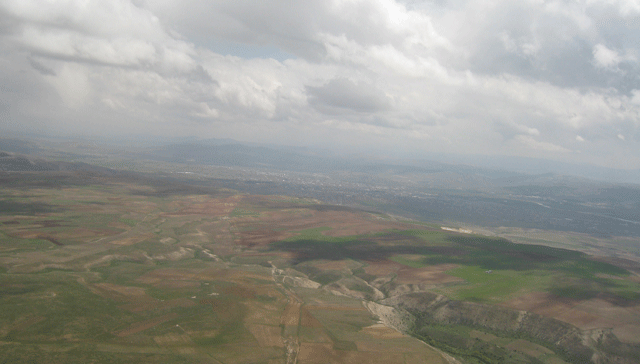 | |
| Photo by Maggie Land Blanck Sivas as seen from the plane. This was actually leaving. It was raining and overcast when we arrived. | |
| | |
|
In Search of Pre 1915 Houses
|
|
We
were met at the airport by Kağan
Çaşkurlu, a native of Sivas and a friend and business associate of Metin's. We made a brief stop at the hotel and then we were off to find some examples of the old style houses of Sivas (Almost all of the current housing in Sivas is in apartment buildings). Kağan knew exactly where to take us, showing us some houses in ruins, some restored houses and the Inönü Konaği Museum (where we got a sense of the interior of houses at the end of the 19th century). We saw houses of a variety of sizes. Some were quite large while other were more modest. Most of the older houses we saw were in the northeast part of the city, not too far from the Inönü Konaği Museum. The Sivas Guide from the Ministry of Culture and Tourism says that the city was divided in residential and commercial districts. All of the house that we saw date from the 19th and 20th century, having replaced the older style flat roofed, one story houses, constructed of sundried brick. Remains of the earlier type of houses are much less common and we did not see any on our visit. In Many Hill Yet To Climb John Minassian indicates that the neighborhood we were in had many Armenian homes. A map in the book shows the location of the Armenian Hospital on AliBaba street (which is where we took a number of photos). Minassian went to visit the home of some friends of his mother's and while he was waiting for the door to be opened he looked around: "Across the street was a beautiful two-story building. When I was young I used to read on the building large letters in gold: GARARBED PERANIAN 1905 — he was a local merchant from Gurum. On another corner in a stone building, one of the best ever made, was the candy-make Avak. A few blocks away was the Armenian hospital, supported solely by Sivas's Armenian community."He listed several other Armenian merchants in the vicinity: Topbashian, Tomajian and Murmurian. In March 2015 Richard Vartanian wrote: "The Tomajian mentioned on page 18, John's father's partner, was the husband of my great-aunt Ana Vartanian Tomajian, sister to my great-great-grandfather Davit Vartanian. The Tomajian's from that marriage are my cousins."See Vartanian and the Tas Han, below.
| |
| | |
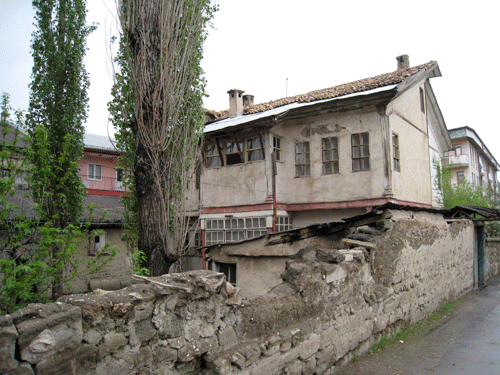 | |
| Photo by Maggie Land Blanck
| |
| | |
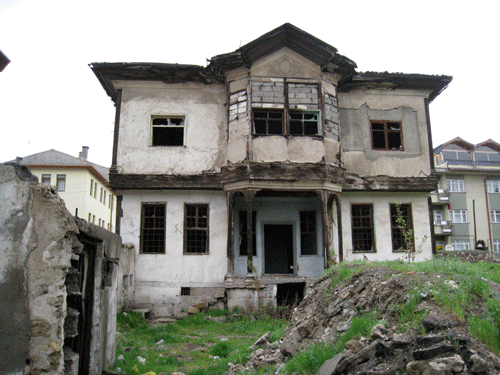 | |
| Photo by Maggie Land Blanck A date over this door is 1890 | |
| | |
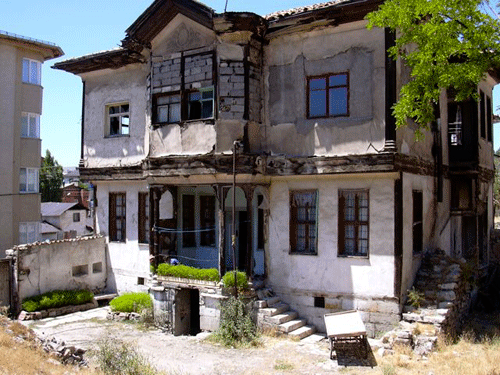 | |
| Photo by a contributer who wishes to remain anonymous The same building pictured above. Photo taken in 2004. | |
| | |
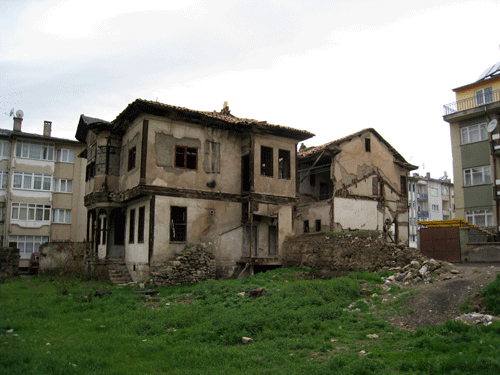 | |
| Photo by Maggie Land Blanck This is the side of the same building pictured above. | |
| | |
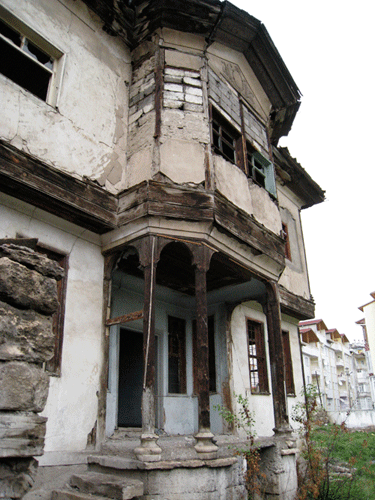 | |
| Photo by Maggie Land Blanck Another side of the same building. | |
| | |
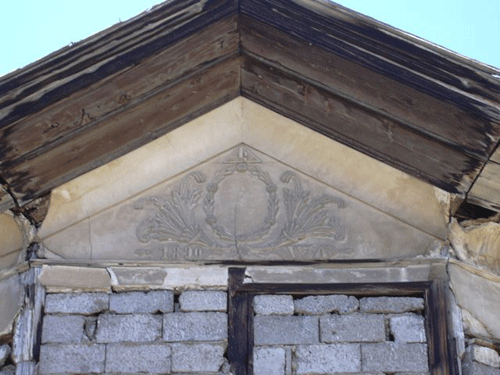 | |
| Photo by a contributer who wishes to remain anonymous This crest over the front door indicates that the house was built or remodeled in 1890. Photo was taken in 2004. | |
| | |
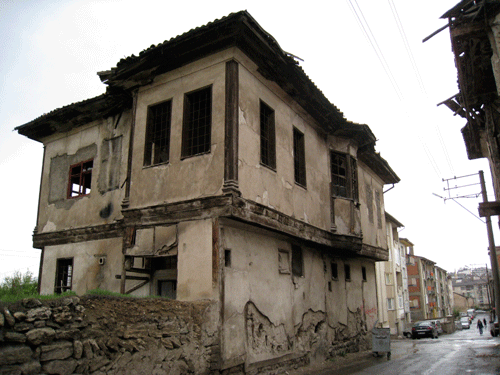 | |
| Photo by Maggie Land Blanck
| |
| | |
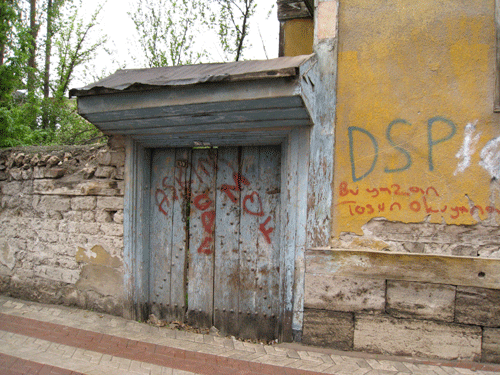 | |
| Photo by Maggie Land Blanck Typical gate. | |
| | |
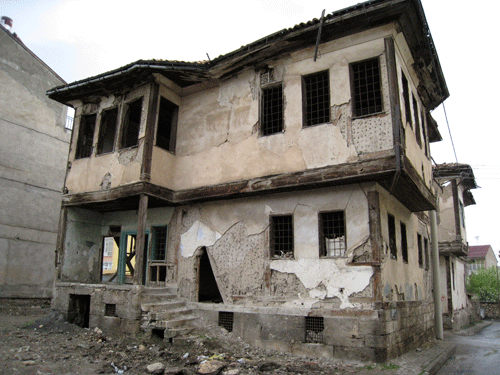 | |
| Photo by Maggie Land Blanck
| |
| | |
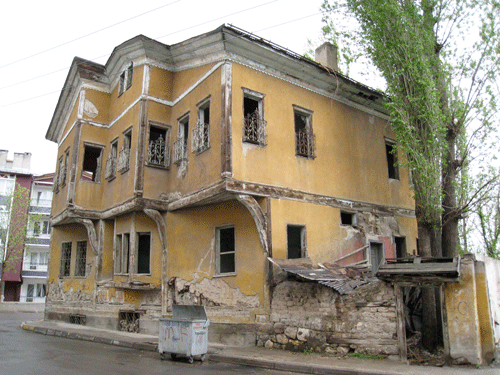 | |
| Photo by Maggie Land Blanck
| |
| | |
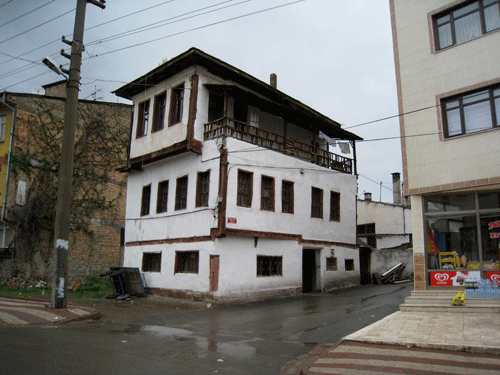 | |
| Photo by Maggie Land Blanck This house and the one in the next photo are basically across the street from one another. | |
| | |
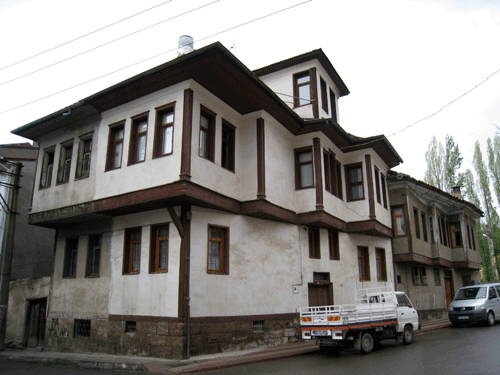 | |
| Photo by Maggie Land Blanck This duplex has one side renovated (or maintained in good condition) and the other side derelict. Bezirci Area, Dispanser Street Numer 27 | |
| | |
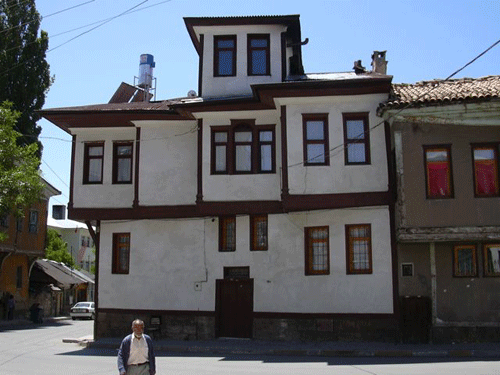 | |
| 2004 photo by a contributer who wishes to remain anonymous This is the same house pictured in the pervious photo. This photo was taken in 2004. | |
| | |
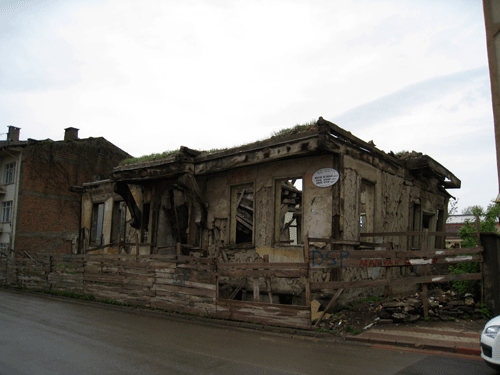 | |
| Photo by Maggie Land Blanck As in many places the beauty of the old becomes apparent when it may be too late in the game. This house was actually marked as slated to be renovated by some conservation group. | |
| | |
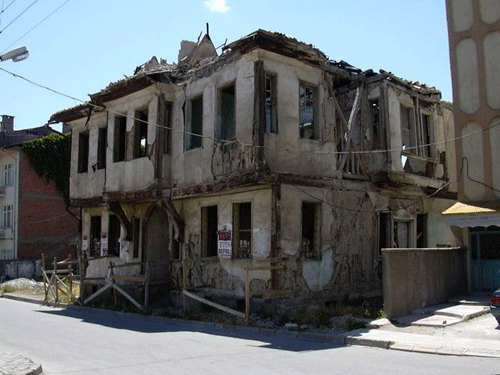 | |
| 2004 hoto by a contributer who wishes to remain anonymous This is the same house pictured in the pervious photo taken in 2008. This photo was taken in 2004 when the building still had two stories. | |
| | |
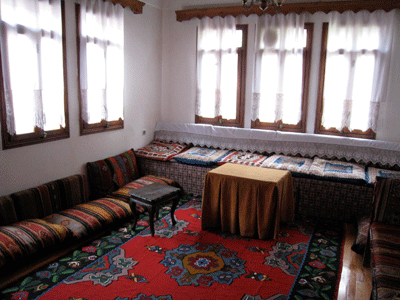 | |
| Photo by Maggie Land Blanck Seating is/was on cushions either on the floor or on benches along the wall. Traditional Armenian Houses in Kayseri (a web site that seems to have disappeared)
"Along the edges of rooms, especially along walls with windows, was a seating area that in Anatolian houses is termed a sedir. This is a simple rectangular structure made of timber that is covered in carpets or cushions. Inside the sedir were box cupboards for the storage of blankets, clothes, etc." | |
| | |
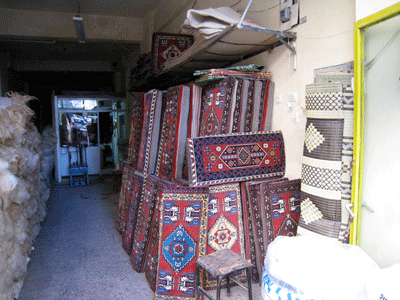 | |
| Photo by Maggie Land Blanck Apparently it is still the custom to sit on cushions in Sivas, as we saw several stores selling these type of cushions. | |
| | |
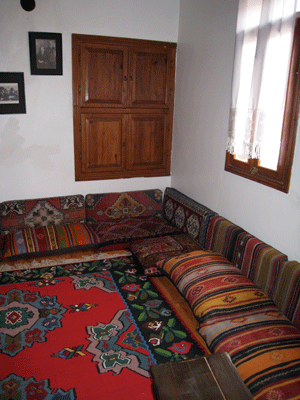 | |
| Photo by Maggie Land Blanck Rooms were multi-functional. The same room would have been used for sitting, eating and sleeping. Bedding was put away in the closets, such as the one on the wall of this room. | |
| | |
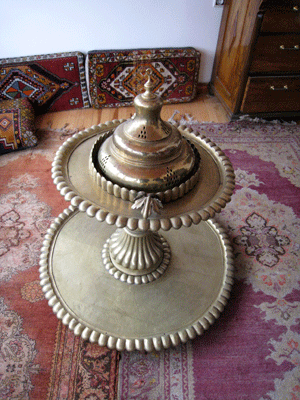 | |
| Photo by Maggie Land Blanck
| |
| | |
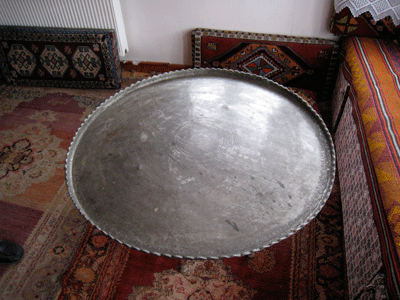 | |
| Photo by Maggie Land Blanck A large copper tray on a low support serves as a table. See Explore Turkey | |
| | |
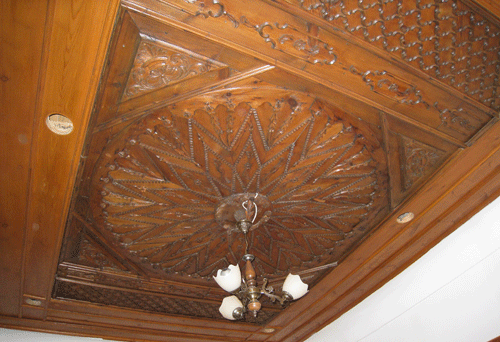 | |
| Photo by Maggie Land Blanck Many homes contained elaborately carved wooden ceiling panels. | |
| | |
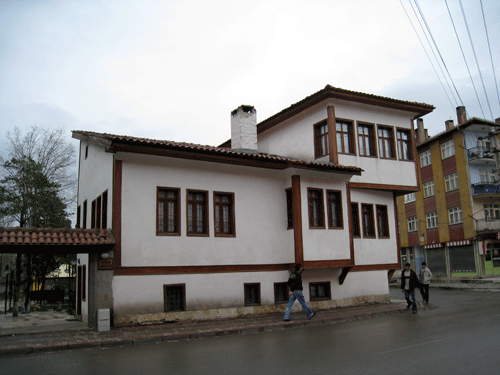 | |
| Photo by Maggie Land Blanck The Inönü Konaği Museum, Ali Baba Cad. Ismet Inönü, the second president of the Republic of Turkey lived in this house from 1891 to 1897 while he was completing his secondary education. This house typifies a home of the upper class of Sivas in the late 19th century. The foundation is stone. The upper two stories are timber frame filled with sun-dried bricks and plastered with lime. The roof is tiled. The overhang of the first and second floors is a feature of the historic architecture of the area. | |
| | |
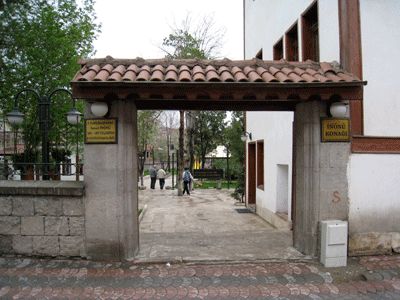 | |
| Photo by Maggie Land Blanck The gate to the Inönü Konaği Museum | |
| | |
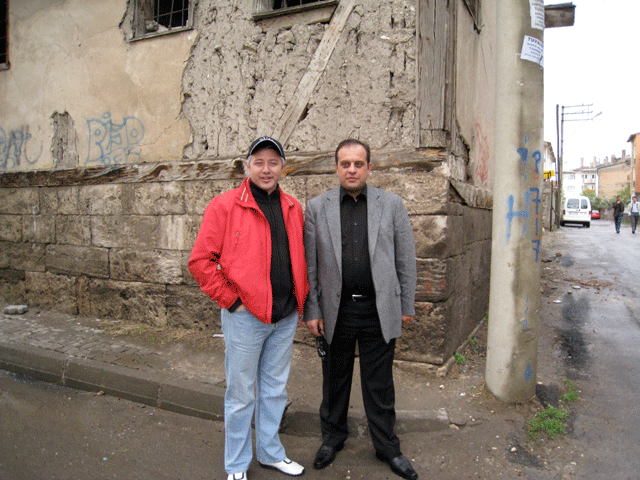 | |
| Photo by Maggie Land Blanck Our guides, Metin and Kağan This picture also shows something of the construction technique. The base is of cut stone with timber frame above. The spaces between the timbers is filled with sun dried brick and then the whole thing is covered with stucco. | |
| | |
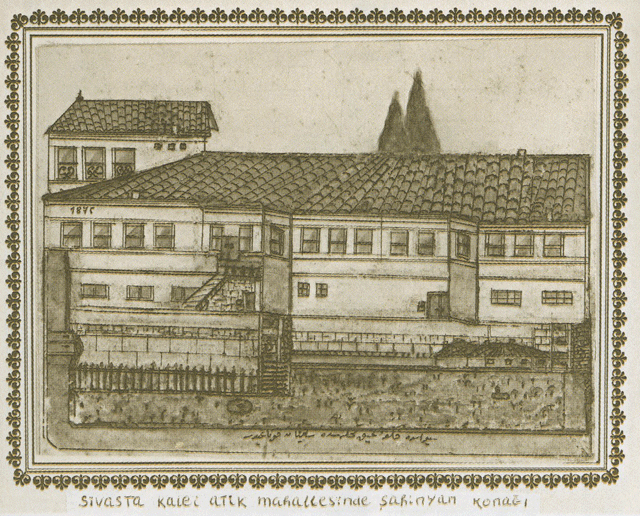 | |
| Sivas 1877, edited by Arsen Yarman A sketch of the home of Hagop Şahinyan, 1875, Kale-i Atik Street, Sivas. This was the home of Ani Çapan's great grandfather, Hagop Şahinyan, an Armenian. In the 1920s it housed the Post, Telegraph and Telephone office. We did not suceed in finding this building. | |
| | |
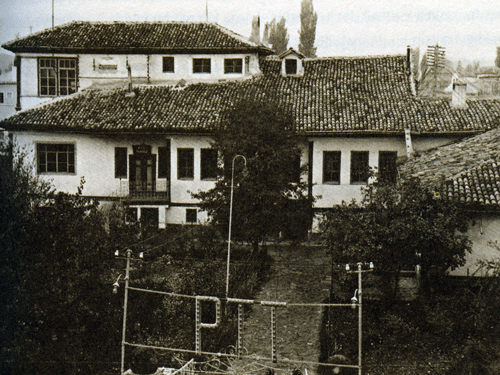 | |
| Sivas 1877, edited by Arsen Yarman Photo of the home of Hagop Şahinyan | |
| | |
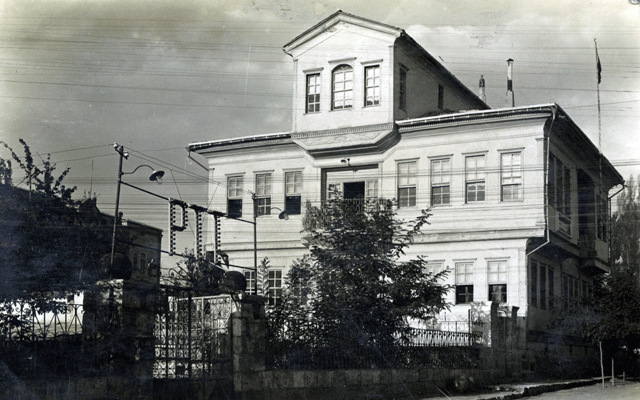 | |
| Collection of Maggie Land Blanck, 2011 Photo of the home of Hagop Şahinyan | |
| | |
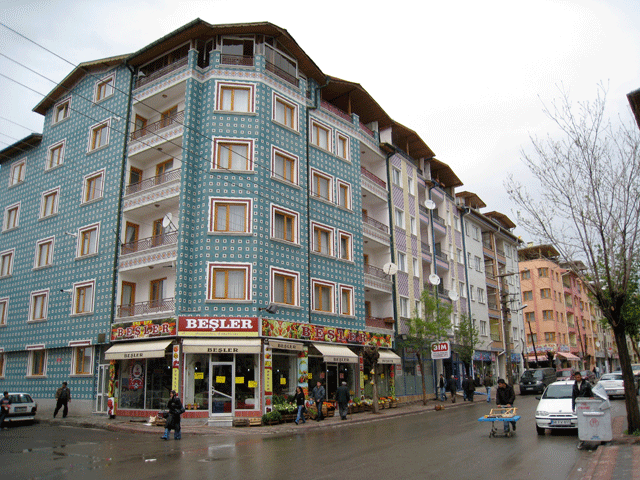 | |
| Photo by Maggie Land Blanck These apartment buildings are typical of housing in Sivas in 2008. The facade of the blue building is covered with small tiles. This was quite common throughout the city. | |
| | |
|
We were told that the house we saw were in the old Armenian area of the city.
There is no way to know that for certain. The Traditional Houses in Kayseri
web site says that
by the 1970 much of the old areas of the
Kayseri was demolished for real estate speculation: "The former Armenian districts
were the last to go, perhaps because of uncertainties
over property deeds...... Most of the remaining old houses are either derelict or in ruins."
This would seem to make sense for Sivas, also. A 1914 map for the city of Sivas in Armenian Sebastia/Sivas and Leser Armenia indicates that the National Hospital (Armenian) and the Armenian and Hripsiman Schools were in the part of the city where we saw the above houses.
| |
| | |
|
A Tomb, A Bath, A Caravansary and A Mosque
Some of the older public buildings are near each other on Arap Şehy and Hoca Ahmet Yesevi.
|
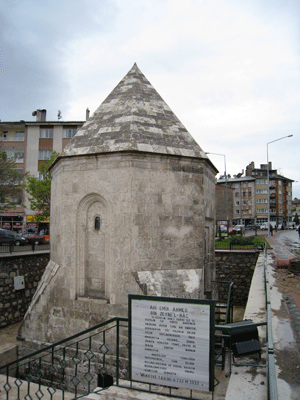 |
Ahi Emir Kümbeti (Cupola) This domed Seljuk grave shrine with a 'mihrab' (niche showing the direction of Mecca) dates to 1332/33. Notice how much lower the ground level was in 1332/33. |
| Photo by Maggie Land Blanck
| |
| | |
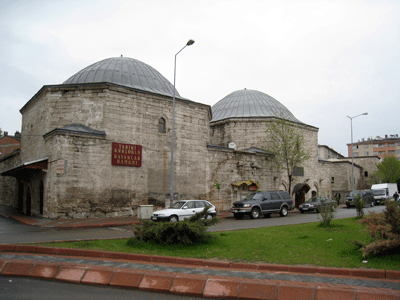 |
Kurşunlu Hamami (Baths) This double bath with men's and women's sections dates to 1579. The bath is still in use today. |
| Photo by Maggie Land Blanck
In May 2012 Arsene Bajakian wrote that his father, who was born in 1905 in Sivas immigrated to Fitchburg, Ma. in 1920. the picture of the bath "Kursunlu hammami" caught my attention. The 1915 map of the city shows a "Kursunlu Paghnic (bath)" located near the Mundar River. I think the picture and the notation shown on the map are the same. | |
| | |
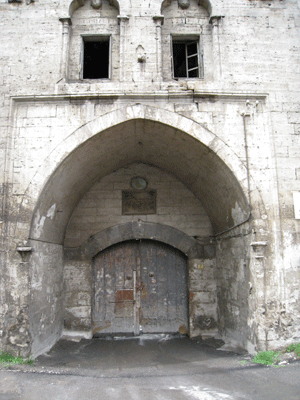 |
Behram Paş Hani or Caravansaray Sivas was a stop on the old silk routes from Europe to the East. There are remains of several Hans or Caravansaries in the city. This one, built in 1576, is situated next to the Kurşunlu Hamami (Baths). It was once used as a calvary barracks. It was closed when we stopped the first time but we were able to get into it later. |
| Photo by Maggie Land Blanck
| |
| | |
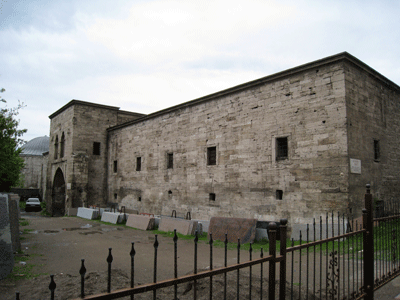 |
Another view of the Behram Paş Hani. The building was being used, at least in part, as some sort of granite and/or stone warehouse. |
| Photo by Maggie Land Blanck
| |
| | |
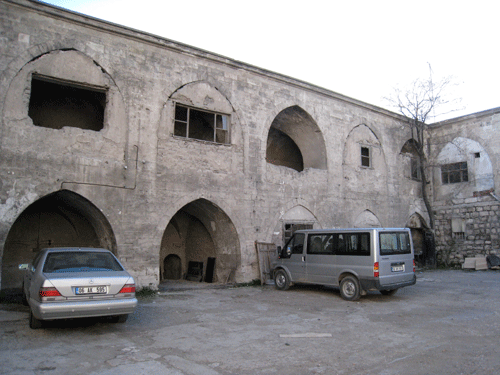 |
|
| Photo by Maggie Land Blanck We returned the next afternoon and the building was opened. | |
| | |
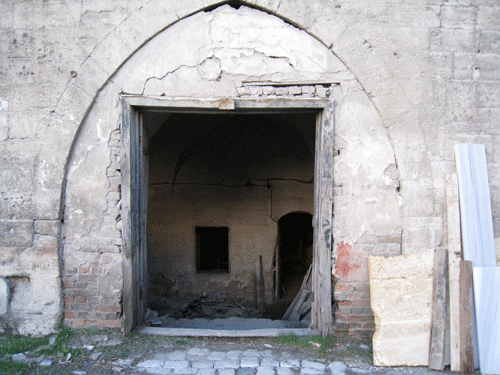 |
|
| Photo by Maggie Land Blanck We understand that there are plans to turn this old han back into a hotel. | |
| | |
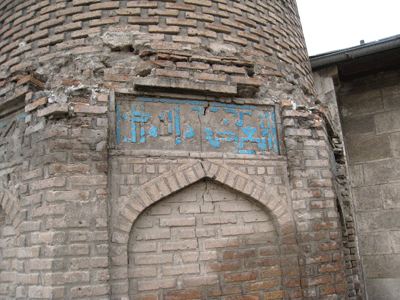 |
Blue tile work on the minaret of the Sivas Ulu Camii (Mosque) The Seljuk Ulu Mosque is one of the oldest in the city and dates to 1196/97. The minaret dates to 1213. |
| Photo by Maggie Land Blanck
| |
| | |
|
Lunch
We drove a little ways out of the city to a lovely spot in the countryside for lunch. We were joined by Cem, another associate and friend of Metin's and Kağan's.
|
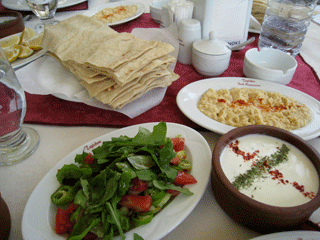 |
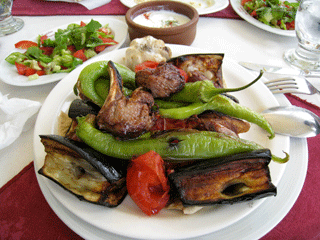 |
| Photo by Maggie Land Blanck Arugula, tomato and pepper salad, the most yummy yogurt with cucumber, and divine eggplant salad were the appetizers. The specialty of Sivas is lamb kebab, with eggplant, tomatoes, hot peppers and roasted garlic. The kebabs are cooked in a special oven where they are hung between an open fire — the spring lamb was wonderful. | |
| | |
|
A View of Sivas From Afar, The Eğri Köprü Bridge and the Red River
On our way back to the city we stopped to view the city from afar and to see a very old bridge that was part of the ancient silk route.
| |
| | |
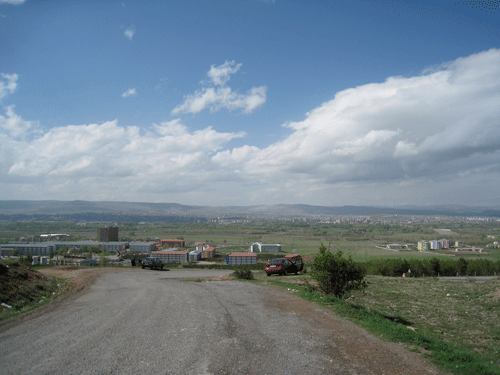 |
|
| Photo by Maggie Land Blanck This hilltop overlooks the Cumhuriyet University Sivas. The university has faculties of Nursing, Physical Education and Sports, Health Services, Medicine, Dentistry, Engineering among others. The city is visible in the distance. | |
| | |
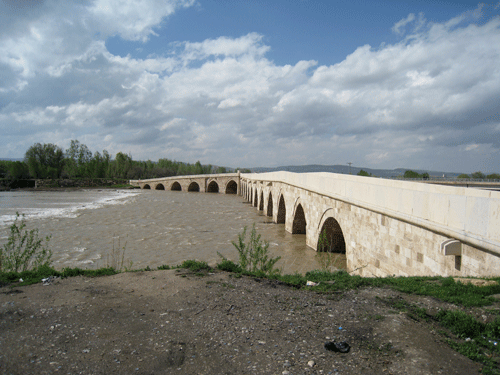 |
|
| Photo by Maggie Land Blanck The Seljuk Eğri Köprü Bridge formed a link in the ancient silk routes between the Sivas-Malatya road and Southeastern Anatolia. Built of cut stone the bridge curves partway across to form a kind of prow against the force of the river's flow. When the winter snows melt the river can run very high potentially washing out bridges. The river called, Kizilirmak (Red River), derives its name from the muddy reddish color of the water. It flows mainly through red sandstone, gypsum and marl which give the water a permanently dull red color. The bridge has recently been restored. In my opinion it suffers from over restoration — an all to common occurrence which somehow detracts from the charm of historic edifices. | |
| | |
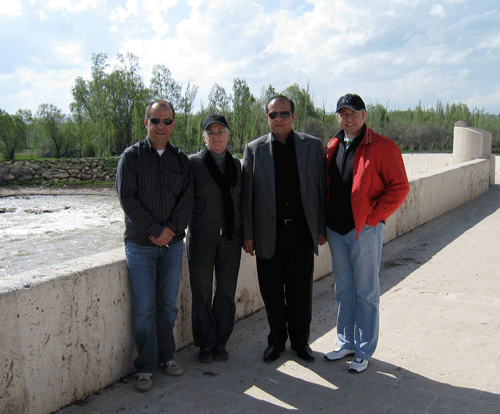 |
|
| Photo by Tom Blanck Cem, me, Kağan and Metin | |
| | |
|
Gök Medrese (Madrasah) and Sivas Kalesi (Castle)
Before calling it quits for the day, Metin, Kağan and Cem took us to see Gök Medrese (Madrasah) and Sivas Kalesi (Castle).
| |
| | |
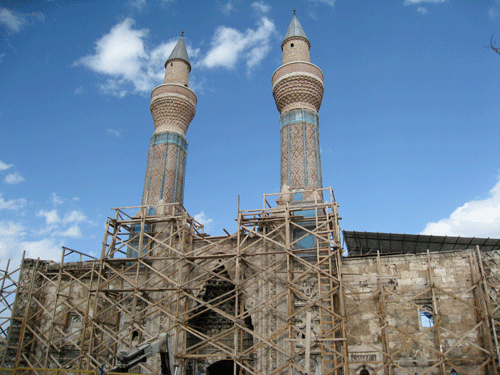 |
|
| Photo by Maggie Land Blanck Gök Medrese (Madrasah) Restoration began on this medrese in 2006. The structure dates to 1271 and has an inner courtyard. Medrese, meaning a place to study, was a college for the study of law and the Koran. See All About Turkey, The Medieval Madrasa | |
| | |
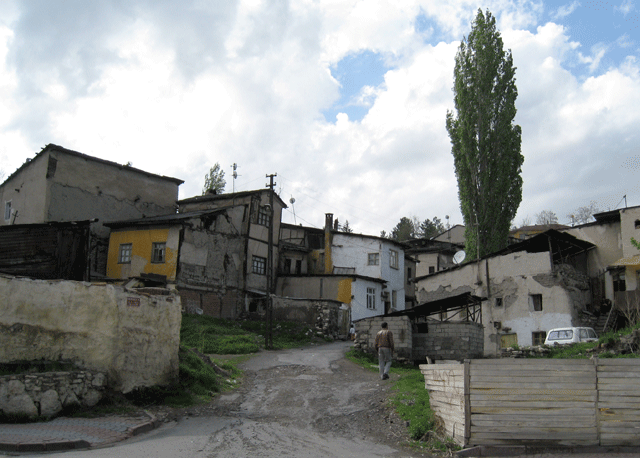 |
|
| Photo by Maggie Land Blanck Across the street from the Gök Medrese were some older houses — humbler and of a different style than those we saw in the morning. | |
| | |
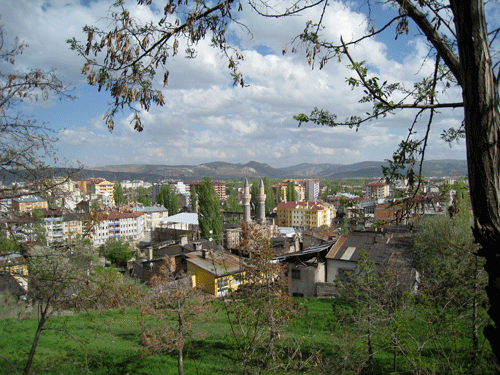 |
|
| Photo by Maggie Land Blanck Just around the corner from the Gök Medrese is the Sivas Kalesi (Castle). The "Castle" is a natural hill. Various rulers of the area took advantage of the geological mass of limestone to build fortification. Nothing remains today but the original hill from which one can see out over the city. The minarets of the Gök Medrese can be seen in the center of the photo. | |
| | |
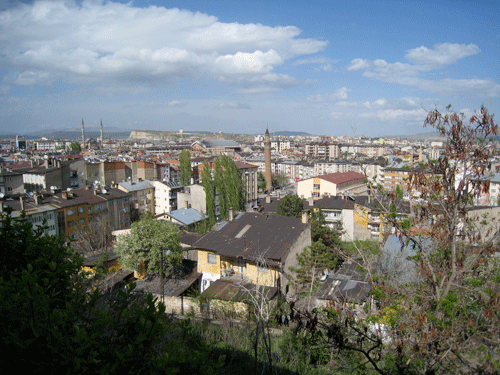 |
|
| Photo by Maggie Land Blanck Another view from the Castle. The lone minaret in the center of the photo is that of the Ulu Mosque. After viewing the City form the Castle, Metin, Kağan and Cem drove us back to the hotel and left us to our own devices for the rest of the afternoon. | |
| | |
|
Çifte Minareli Medrese, Kale Camii, Buruciye Medrese,
Şifaiye Medrese, another Caravansaray and the Zeya Bey Library
We took off on our own to visit the Çifte Minareli Medrese, the Kale Camii,
Şifaiye Medrese and
the Buruciye Medrese,
all located in the the park near the Government Square.
Other web sites have better images than I got of the Çifte Minareli Medrese,
the Kale Camii, Şifaiye Medrese and
the Buruciye Medrese. These buildings are among the better known and
important structures in Sivas. The Kale Camii was built in 1580. The Buruciye Medrese was built in 1271. In 2008 it was the home of a tea house and some small shops. The Şifaiye Medrese built in 1217 is a complex of buildings that was once a medical school. It was turned into a medrese by imperial edict in 1768. It also once housed tea houses and small shops but at the time of our visit it was under renovation or excavation The Çifte Minareli Medrese was built in 1271. The only surviving part is the front wall. This building was used as a hospital in 1882 and later as a school. See Dick Osseman Photos of Sivas for some great images of the historical buildings of Sivas.
After wandering around this historic area for a while we took a walk along Ataturk Cadessi to the Taş Han (Caravansary) where we had çay (tea). Then we passed the Zeya Bey Library and took a look around the fruit and vegetable the market which was pretty quiet as it was getting late. On our way back to the hotel we stopped for Lahmacun (yum!). In the evening we joined hundreds of others for a stroll on Inönü Boulevard before retiring for the night. A very full and satisfying day in Sivas with a little help from our friends, Metin, Kağan and Cem.
| |
| | |
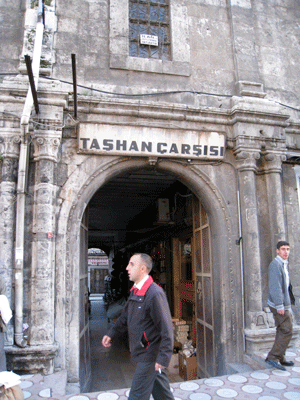 |
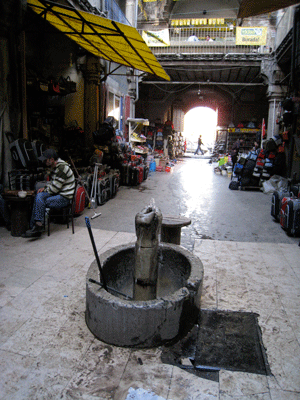 |
| Photo by Maggie Land Blanck The side entrance and first floor of Taş Han
Taş Han was built in the second half of the 19th century on the site of an earlier building. Notice the fountain which was an essential part of every han. | |
| | |
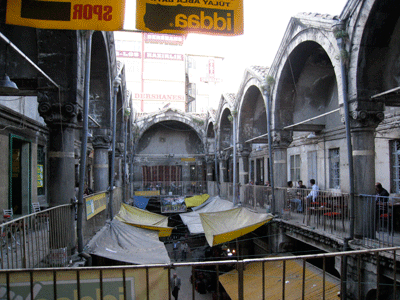 |
|
| Photo by Maggie Land Blanck The second floor of Taş Han
| |
| | |
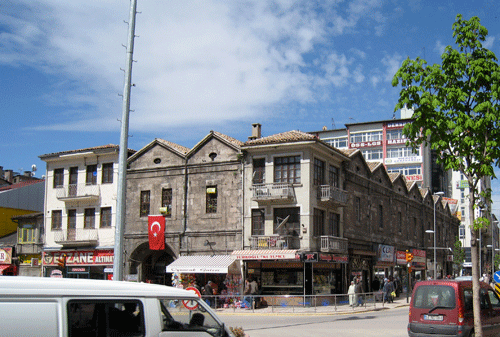 |
|
| Photo by Maggie Land Blanck Taş Han We were told that all of the buildings on this corner were once owned by Armenians. In Many Hills Yet To Climb John Minassian says his father, Bedros, an Armenian who converted to Protestantism, had a partnership in a shop in the Taş Han in 1895. He says that only the best merchandise was sold there. The Minassian family moved from Sivas to Gurun in 1906. Gurum was where Bedros was born and raised and had sons from a first marriage. In March 2015 Richard Vartanian, the great grandson of Avidis Minassian, wrote to say his ancestor, Avidis Minassian, owned the Tas Han and all the buildings on that corner. Richards is the grandson of of Rebecca Minassian Vartanian a daughter of Avidis Minassian. After the death of Avidis his son Vahan Minassian (the brother of Rebecca) took over the business and properties. Uncle Vahan disappeared after the Gendarmes took him away in early 1915 for questioning, & he never returned, despite promises & bribes paid.Tavit Minasyan is pictured on page 313 of Sivas 1877
| |
| | |
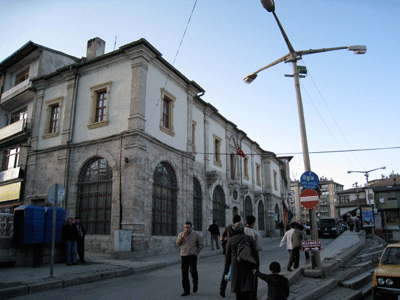 |
|
| Photo by Maggie Land Blanck Near the market is the Zeya Bey Library of Handwritten Works, build in 1908 and founded by Yusuf Ziya Başara.
| |
| | |
|
A Trip to Pirkinik
The next morning Kağan introduced us to Yervant, one of 76 Armenians still living in Sivas. Yervant, Metin, Kağan, Tom and I then drove to Pirkinik, the village in which Tom's grandmother, Lucy Areivan, was born.
| |
| | |
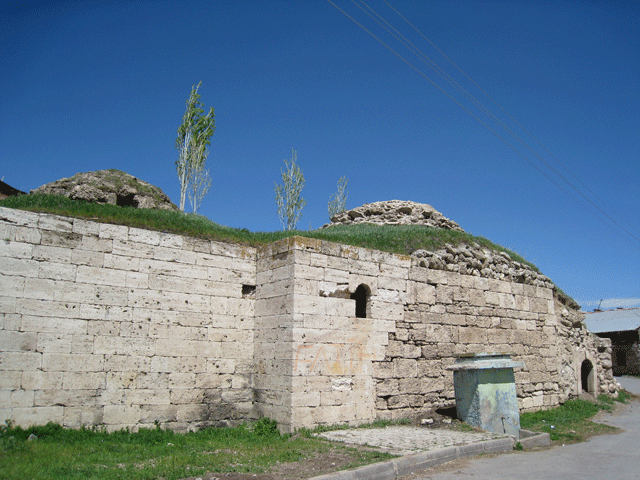 |
|
Photo Maggie Land Blanck The remains of the baths in Pirkinik. For more images of Pirkinik go to Pirkinik
|
|
The Armenian Cemetery and the ruins of an old Armenian Church
After our visit to Pirkinik, Yervant took us to the Armenian Cemetery and the ruins of an old Armenian Church.
| |
| | |
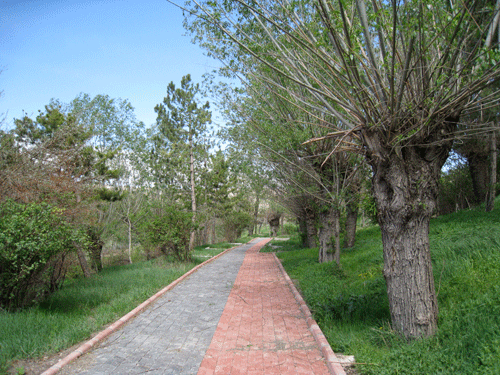 |
|
| Photo by Maggie Land Blanck The pre 1915 cemetery is now located on a military base, so we were not able to see exactly where it was located. However, we were told that none of the stones remained. | |
| | |
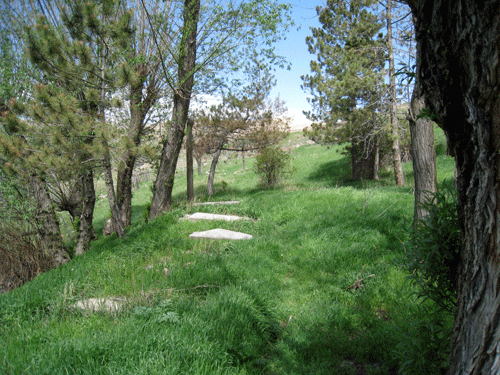 |
|
| Photo by Maggie Land Blanck The new cemetery lies just outside the military base. The graves are very simple, just covered with cement slabs. There have been some problems in the past with grave robbers looking for gold. Now the soldiers keep an eye on things but the Armenian community has elected to keep things as low key as possible. | |
| | |
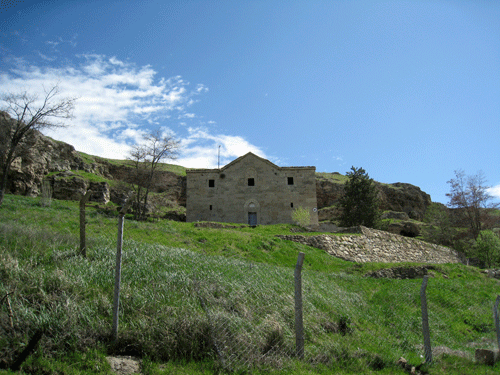 |
|
| Photo by Maggie Land Blanck The ruins of an Armenian church. The church was actually on the military base so we were only able to look at it from a distance. Other images of the church can be seen at Sole Surviving Armenian Chruch in Sivas I had hoped to find the remains of an Armenian church in Sivas itself. I had assumed that a building might still remain having been put to some other use, perhaps converted into a warehouse. That does not appear to be the case. We were told that all of the Armenian churches in the city were torn down, which seems like a lot of work.
| |
| | |
 |
|
| Even stranger is the razing of the Monastery of the Holy Cross. Called Surp Nishan (Nisan) the monastery was about a quarter of an hour outside the city by horse back on the way to Tokat. Several web sties say that it was located on the military base north of the city — not far from the church pictured above. The monastery originally dated to the 11th century. It reportedly housed the Armenian king Senekerim's crown, throne, scepter and other treasures. We were told that it was completely demolished in 1978. | |
| | |
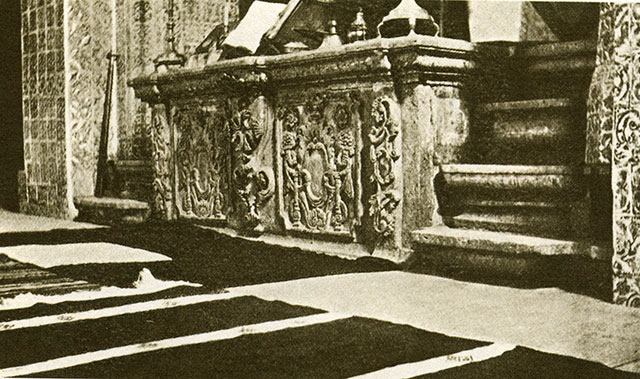 |
|
|
Byzantine stone reading desk in Chapel, St. Nishan's Monastery, Sivas Across Asia Minor on Foot W. J. Childs 1817 Childs visited the monastery in the company of one of the America missionaries and met with the "Armenian Bishop of Sivas" who was a "long-haired, black gowned cleric". Childs says that the monastery dated to the 13th century. He further noted that the Bishop was later tortured and died on the road to Mosul. | |
| | |
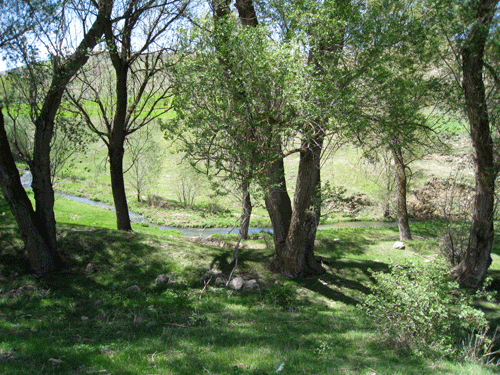 |
|
| Photo by Maggie Land Blanck Below the Armenian Church and outside the base runs a pretty little stream. In this bucolic setting farmers raise cattle and sheep. | |
| | |
|
Lunch at Mis Kebap
Another great meal of Döner Kebab with pita, onions, tomatos and peppers | |
| | |
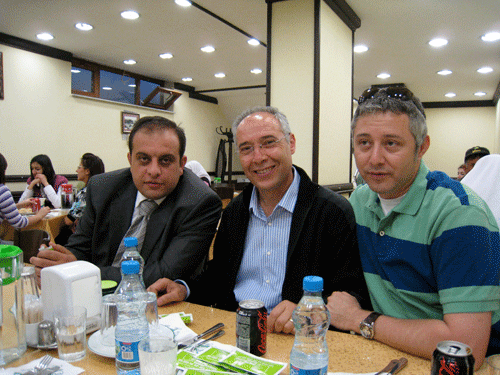 |
|
| Photo by Maggie Land Blanck Kağan, Yervant and Metin | |
| | |
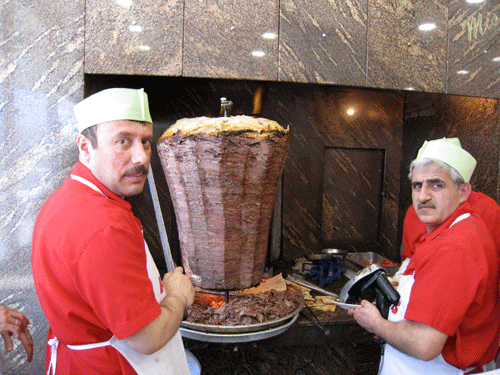 |
|
| Photo by Maggie Land Blanck Döner Kebab at Mis | |
| | |
|
The Afternoon's Activities After lunch, Metin, Tom and I walked through the Seljuk ruins in Goverment Square, had çay in the courtyard of the Buruciye Medrese, and tried to get into the Ataturk Museum (which was closed because it was Monday). We stopped at the Sivas Tourist booth where I obtained several booklets, maps and a CD on Sivas and its history. These publication, made available for free through the Sivas Governorship Province Directorate of Culture and Tourism have been the source of much of the information on this page. We spent some time trying to find postcards, with no success. Guess there aren't enough tourists in the area to warrant postcards. In fact, we did not see any other tourists during our stay or on the planes coming and going. | |
| | |
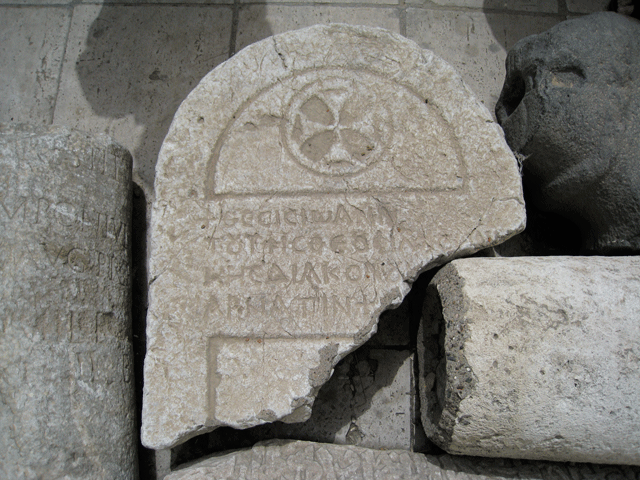 |
|
| Photo by Maggie Land Blanck Some old carved stones lying on the side of the Ataturk Museum | |
| | |
|
The Evenings Activities We went back to the hotel around four o'clock and took a rest. Invigorated after our nap we again went wandering around the city. We passed another old bath, the Tarihi Meydan Hamami. We stopped at the Behran Paş Han which was open. We also found the Subaşi Han. In a little place right in back of our hotel we had more great kabab for dinner — this time chicken and adana kebab. It was accompanied by the usual excellent tomato salad and spaghetti with yogurt — not as strange as it sounds. After dinner we took another stoll along the Inönü Boulevard. | |
| | |
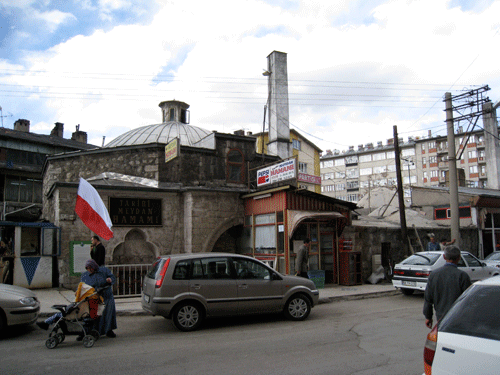 |
|
| Photo by Maggie Land Blanck Tarihi Meydan Hammi — another bath house | |
| | |
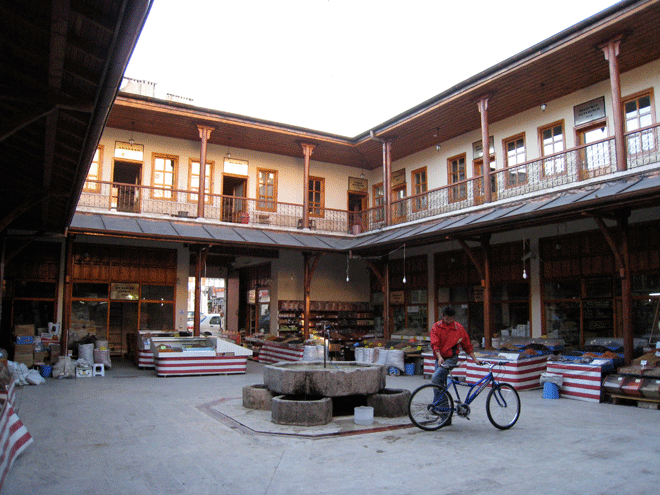 |
|
| Photo by Maggie Land Blanck Subaşi Han (Caravansary) This han has recently been restored. It is in two sections. The "Develik" or camel stables on the east were constructed of thick stone in the 14th century. Additions were made circa 1525. The section shown in this image was added in the 1800s. | |
| | |
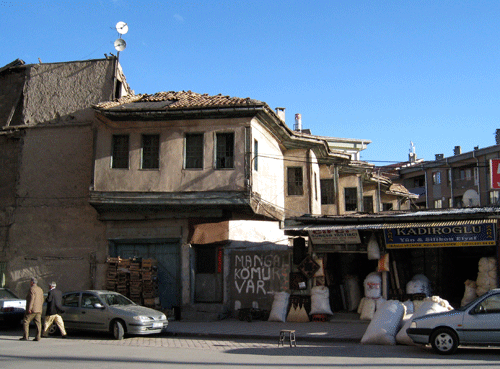 |
|
| Photo by Maggie Land Blanck Another old house in ruins. | |
| | |
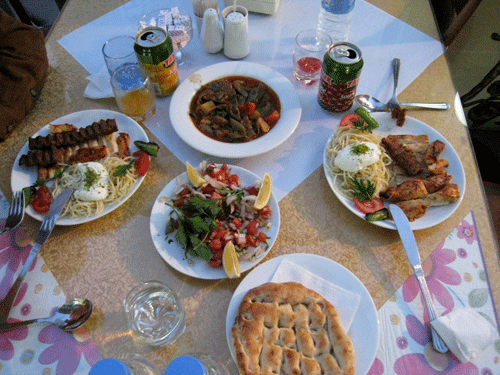 |
|
| Photo by Maggie Land Blanck Dinner This small kebab shop had some interesting wood carved plaques that depicted county life in a time gone by. The manager gave me permission to photograph them and they can be see on the Perkinik page. | |
| | |
|
Tuesday Morning We got up early in order to make a quick trip to the Ataturk Museum. And then we were on our way back to Istanbul. |
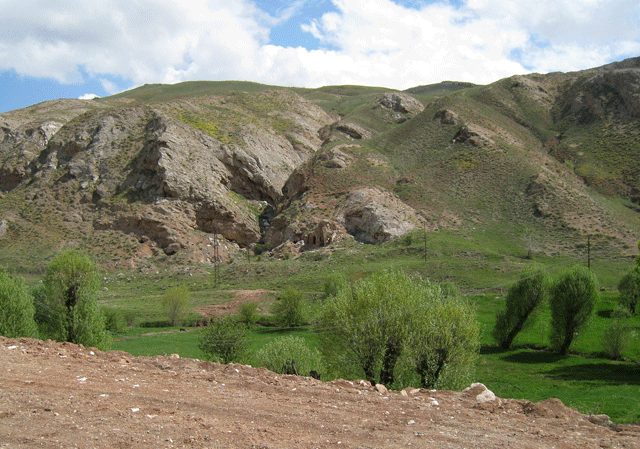 |
|
| Photo by Maggie Land Blanck On our way to the airport Kağan pointed our the ruins of another Armenian church (just about dead center in this picture and looking very much like the rocks surrounding it). This image also gives some sense of the terrain around Sivas.
| |
| | |
|
Thank You Every Who Made Our Trip to Sivas so Special
We throughly enjoyed every minute of our visit to Sivas. We had fun, we learned a lot and we ate well. The people were helpful, kind and warm. The food was extraordinary: wonderful kabobs, yummy salads, great fruit and delicious creamy yogurts. Our thanks to everyone who helped make it such a special trip: Etem who put us in touch with Metin, Metin for his good humor and great job as translator, Kağan for chauffeuring us all over the place, Cem for his pleasant company, Yervant for showing us the the Armenian sites of interest and for putting us on to the excellent book, Sivas 1877 written in part by Bogos Natanyan and added to and edited by Arsen Yarman. And thanks to all the people who showed us small acts of generosity: the cheese man in the supermarket who gave us tastes of cheese, the produce vender who rearranged the grape leaves so I could take a picture, the fruit vendor who one evening gave us strawberries and the next evening gave us small tart green plums, the shopkeeper who gave me a free Sivas pen, and all of the merchants of various kinds who allowed me to take photographs of their stalls and shops and greeted us with such big smiles.
| |
| | |
|
Dick Osserman's photos of Turkey Dick Osserman has taken some wonderful pictures of Turkey which can be seen at Dick Osserman His pictures of Sivas are at Dick Osserman, Sivas Turkey
| |
| | |
| Some Facts About Sivas Sivas, at an altitude of 1275m (4,183 ft) above sea level, is the highest city in Central Anatolia. It is the second largest city in Asian Turkey with a 28,488 square kilometer area. It lies to the north of the Kizil Irmah (Red River) in a broad valley surrounded by sparsely wooded mountains. Winters are cold and severe with frequent heavy snow falls. Snow covers the ground for 3 to 5 months of the year. Summers are hot and dry and the spring and fall are rainy. The city may date to pre-Roman times. During the Roman era it was called Sebastia. Under Diocletian it became the capital of Armenia Prima. Under Justinian it was the capital of Armenia Secunda. St Blaze (Blasius), present at council of Nicaea in 325, feast day February 3, was a bishop of Sivas. The Armenian Catholic Church in Sivas was called St. Blaze. There was an Armenian dynasty in control of the city to 1080. At the beginning of the 11th century the city was under the suzerainty of the Greek emperors. It was controlled by Turcoman emirs in the 12th century. It was controlled by Seljuks princes in the 13th century. Under the Seljuks it reached great prosperity to become one of the largest and most important cities in Anatolia and a center of learning and culture. It is known for its Suljuk architecture. Sivas lay at the juncture of the Persia and Baghdad caravan routes which made it a busy commercial center in ancient times. The trade route between the East and the West, known as the Silk Road, was in reality a series of routes that converged and diverged at multiple points. Sivas was situated on the Silk Road at a confluence of roads coming from Constantinople (through Ankara or along the Black Sea) in the west and from the Egypt and Syria in the south. Trade between China and the West existed from ancient times. The Assyrians, Persians, Greeks and Romans went through Sivas, as did Marco Polo on his trip to the East. Few actually made the whole trip from West to East as Polo did. Most traders did a section of the route and then went back to their home base. Consequently, the goods passed through a series of hands en route. As an important hub on the Silk Road, Sivas was a place to replenish supplies, trade, and fatten up the beasts of burden.
"The position of Sivas is one of great importance because it commands the approach to the one main pass which crosses the Anti-Taurus from Anatolia into Armenia, and forms the line of communication between the Black Sea by way of Samsoun and the interior of Asia Minor on the one hand and the valley of the Tigris and the Persian Gulf on the other. Under these circumstances it is not surprising to find that the site has been occupied form ancient times."
The Franciscans established a monastery in Sivas by 1279 In the 17th century there were approximately 6,000 houses in Sivas. The Vilayet (Civil Province) of Sivas was created in 1864 and included the "sanjak" of Sivas. In the sanjak of Sivas were 26 Armenian villages where the population was mostly engaged in agriculture and handicrafts. In the city of Sivas the Armenian populations was mostly engaged as merchants, traders, artisans, money lenders and money changers. Most of the trade in the area was in Armenian hands. Sivas was the see of the Armenian Catholic Church from 1858. In 1892 it became an archiepiscopal see. In Armenian, A Historic Atlas Robert H Hewson lists the following but does not date this information
He also mentions that Sivas was an important center of the Protestant Missions who were there as early as 1851.
Appletons' Annual Cyclopedia and Register of Important Events of 1881 approximated the population of Sivas at 35,000 to 40,000. A massacres of Armenians took place in Sivas in 1894-1896 Although it's glory had faded after the Seljuks, Sivas remained an important provincial capital during the Ottoman Empire. In September 1919 it was the site of the second national congress organized by Mustafa Kemal (Ataturk) who later became the first president of Turkey. The development of the railroads in the early 1930s again brought prosperity to Sivas under the Republic of Turkey. Sivas was connected to Ankara in 1930 and Samsun and the black Sea in 1932.
Pirkinik (Prknig)
According to a compilation of records Lucy Hagopian was born on January 15, 1875/76 in Pirkinik, Turkey the daughter of Hagop and Annik Hagopian (Agopian). Her siblings were Hagop, Baptist, Hovaness, Christine, and Nazareth. This family were Roman Catholics and claimed to be descendants of the Pakradouni. The village of Perkenik, a short distance from the city of Sivas, was a Roman Catholic center. In February 2007 Robert Haroutunian wrote: My Late Aunt's mother in-law was a native of Prknig village of Sepasdia. My cousin Margaret is her granddaughter. Also, in the 1970s Armenian writer Taniel Varoujan's daughter lived in New York City. He also was from this village and was related to my cousin's grandmother's family. The grandmother's name was Pepron she was born in 1900 and I remember her when I was a kid. She also was Catholic. She used to say that the Armenians of this village were descendants of the Pakraduni Armenian Royal family.In 850 Ashod Pakradouni was appointed Governor of Armenia by the Arab caliph. In 884 he became King Ashod I. The Pakraouni dynasty ruled for 150 years. In 1045 the Pakradouni king, Gagig II, abdicated and so ended the last Armenian kingdom. Pakraduni is also spelt Bagratuni. Pirkinik in 1915
"In the parish of Sivas, the only village to have been spared is Pirkinik, where the archbishop, Monseigneur Ketchedjian, has escaped to. He, and one cleric that accompanied him, are the only survivors."DOCUMENTS FROM THE DANISH NATIONAL ARCHIVIES DOCUMENT 1 1915-07-03-DK-001 There a several web sites with the same quote about the village in 1915. To see images of Pirkinik go to Pirkinik
|
| Descriptions of Sivas from Articles and Books |
|
The Travels of Marco Polo
Marco Polo was born in Venice in 1254. He traveled with his father and uncle to China in 1271 where he spent the next twenty years. Upon his return to Europe he was imprisoned in Genoa. It was probably while he was in prison that he collaborated with Rustichello of Pisa to write his memories.
"Let me begin with Armenia. The truth is that the are actually two Armenians, a Greater and a Lesser. The lord of Lesser Armenian is a king who maintains good and just government in his country under the suzerainty of the Tartars.* It is a land of many villages and towns, amply stocked with the means of life. It also affords good sport with all sorts of wild game, both beast and fowl. The climate, however, is far from healthy; it is, in fact, extremely enervating. Hence, the nobility of the country, who used to be men of valour and stalwart soldiers, are now craven and man-spirited and excel in nothing except drinking. The book of Marco Polo, the Venetian: concerning the kingdoms and ... By Marco Polo annotated by Henri Cordier, Henry Yule and Amy Frances Yule - 1903 Annotations to The Travels of Marco Polo with regard to the city of Sivas, Chapter II:
One of the oldest churches in Sivas is St. George (Sourp-Khiork), occupied by the Greeks, but claimed by the Armenians; it is situated near the centre of the town, in what is called the "Black Earth," the spot where Timur is said to have massacred the garrison. A few steps north cf St. George is the Church of St. Blasius, occupied by the Roman Catholic Armenians. The tomb of St. Blasius, however, is shown in another part of the town, near the citadel mount, and the ruins of a very beautiful Seljukian Medresseh. (From a MS. Note by Sir H. Yule. The information had been supplied by the American Missionaries to General Sir C. Wilson, and forwarded by him to Sir H. Yule.) Travels of Mirza Abu Taleb Khan in Asia, Africa, and Europe ..., Volume 2 By Abu Talib Khan, 1810
"On the 21st we reached Sewas. The distance between it and Tokat is ninety-six miles, and is generally performed in one day; but, on account of the badness of the weather, and the fear of being lost in the snow, I took two days to it. During these two days it snowed very hard, and blew with such violence that two of the mules, which were heavy laden, fell down precipices, and were dashed to pieces. Journey Through Asia Minor, Armenia, and Koordistan, 1813, John Macdonald Kinneir ITENERIES TO CONSTANTINOPLE, BY SIVAS AND TOCAT, BY THE AUTHOR, IN THE WINTER OF 1810.
"it is dirty and ill built, has a town clock (a wonder in this part of the world,) and is the seat of the pasha. The inhabitants are a course and rude people, and great breeders of horses. The castle is in ruins, and not far from the Town is a celebrated Armenian monastery."Note: The monastery was Surp Nisan.
Bulletin de la Société de géographie By Société de géographie (France), 1832
ITINERAIRE DE SEWAS A ALEP. The journal of the Royal Geographic Society of London, Volume 6 By Royal Geographical Society (Great Britain) 1836
On the road from hence to Sivas there are two large salt-works: the salt is procured from springs; the surrounding country is supplied from them, and the government is said to derive considerable revenue from the works, which belong to it. The country from U'lash till I reached the plain of Sivas was mountainous, not entirely without cultivation, but I did not pass any village. A personal narrative of the Euphrates expedition, Volume 2 By William Ainsworth, 1835, 37 & 37
The next day we travelled over a lower country, but of similar formation, nine hours, or some twenty-seven miles, to Siwas. The only novelty was that there were several lakes in hollows, but whether temporary inundations or permanent lakes I could not determine. The pretty mustella before alluded to abounded by the road side. The Missionary herald: Volume 33 - Page 394 American Board of Commissioners for Foreign Missions - 1837
EXTRACTS FROM THE JOURNAL AND LETTER OF MR. JOHNSTON |
|
Travels and researches in Asia Minor, Mesopotamia, Chaldea, and ..., Volume 2 By William Ainsworth 1842
Sivas is a large town containing a population of 16,000 souls, of whom 4000 are Christians. It is the seat of a pasha, very centrally situated, and would afford, now that steamers ply to Samsun, a very excellent depot for English manufactures and goods, which would find a ready market. The business done in the bazaar as it is, is considerable, and the Christian merchants are rich and industrious. The city is not very healthy, being low, and the streets narrow and dirty; but there are many good positions in the neighbourhood. 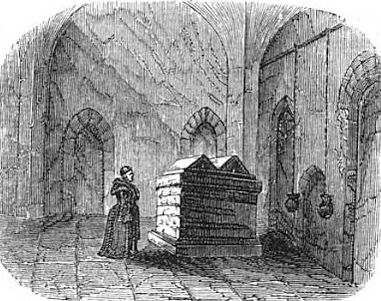
Narrative of a visit to the Syrian [Jacobite] Church of Mesopo tamia By Horatio Southgate - 1844
We found the whole country, from Zara to Sivas, a distance of thirty-six miles, suffering from the effects of famine. There had been no rain the preceding year, and all the grain which should have been preserved for seed had been consumed by the famishing inhabitants. This year the rains were abundant, but they fell upon uncultivated soil. The people had no grain to put into the ground. Their means had been spent in providing for their families and their cattle, and the price of wheat had increased ten-fold. The peasants of Godin had fared better, as their gains in the capital had enabled them to support themselves during the scarcity, and they were now rejoicing in the prospect of a luxurious harvest. But the other villages, and Zara especially, seemed likely to become entirely depopulated. The people were abroad in the fields collecting weeds and herbs for food. Their wan and haggard appearance was enough of itself to show that they had suffered severely. |
|
The Spirit of Missions, the Episcopal Church Board of Mission, 1845 Armenian Papists, "were said to number fifteen families in Sivas and three hundred and fifty in Pirkinik a village near Sivas." *Roman Catholics
Notes from Nineveh: And Travels in Mesopotamia, Assyria and Syria, James Phillips Fletcher, 1850 Fletcher described Sivas as cold in the winter with "icy blasts from the nearby mountains". In the summer the nights "present a freezing contrast to the heat of the days".
"The modern Sebaste is not celebrated for its cleanliness, as it is one of the most filthy towns I ever passed through: not does it possess and edifice worth noticing. Its only advantage seems to be a fine view of the neighboring mountains". Commercial statistics: A digest of the productive resources, commercial ... By John Macgregor 1850
Skins. - " ....... Of cow and ox-hides, independent of those remaining for home use, about 50,000 are available for export, a great many cattle brought from Erzeroom and Sivas being annually slaughtered for making pastoormah, or beef preserved with garlic and pepper, and dried in the sun for winter food. Besides providing all Anatolia, Aleppo, and Damascus, 4000 to 5000 packages, or about 6000 cwt. yearly of it, is sent to Constantinople. Report of the American Board of Commissioners for Foreign Missions - Page 70 American Board of Commissioners for Foreign Missions - 1851
Sivas, 54 miles from Tokat, in a fine climate, on the highest table land of Asia Minor. - Armenians, 10,000. The little church, though without a pastor, assembles regularly for worship. There is much religious discussion in the place, and infidelity has raised its standard. A resident missionary is much needed. The Armenians of the 17 villages about Sivas, are calling for instruction. The Missionary herald at home and abroad, Volume 51 By American Board of Commissioners for Foreign Missions, General Council of the Congregational and Christian Churches, 1855
Sivas is elevated about four thousand feet above the level of the sea. The height of Tocat is estimated at fifteen hundred and eighty feet. The winters of Sivas are usually quite cold; and the snow accumulates to the depth of several feet. Wood, however, is comparatively plenty, and not very expensive. Within the city are vegetable gardens; and some of the more hardy fruit-trees flourish. Some tall poplars and willows give the city a pleasant aspect, as viewed from a distance. The Bombay quarterly review, Volume 7, 1858
On the next plateau stands the city of Sivas, a place similar to Amasia in population, but of greater importance than Amasia. The river Halys, supposed to be the Pisou of Scripture, is said by Chesney to be useless for the purposes of navigation on account of its rocky bed and of the steep descent by which it reaches the Euxine, but in length of course, and in volume, it rivals the principal rivers of Asia. In the neighbourhood of Sivas it is spanned by two stone bridges built in the form of two sides of a triangle. Within the city of Sivas there are more objects of interest than are usually to be met with in a Turkish town, amongst them a redoubt and an extensive cemetery, and through the town an arm of the Halys flows. In the spring time this city, like every other town in Turkey, is the receptacle of an almost inconceivable amount of mud, and the traveller who presents himself in the market-place is sure here as elsewhere to be threatened with demolition by a pack of hungry curs. Some idea may be formed of the importance of this the ancient capital of Cappadocia by the fact that there are now no fewer than a hundred mosques within its walls. The great plain on which it stands is said to be extremely fertile, and it affords pasture to vast herds of cattle. A village above Sivas, called Yelietass, marks the highest point of this road across the Taurus range. We have now travelled a distance of two hundred and fifty miles from Samsun by the road, and at the subterranean village of Yelietass we are six thousand four hundred and seventy feet above the level of the sea. The following figures show the height of Amasia, Tocat, and Sivas respectively. Amasia 1,070; Tocat 2,346; Sivas 4,670. From these figures it will be seen that the last portion of the ascent is remarkably steep, since Yelietass is but one stage distant from Sivas. Here for six months of each year the mountains are covered with snow, and during those months the inhabitants live almost entirely under ground. But for the smoke ascending from the chimneys a traveller might pass the village without knowing of its existence. From this spot nothing is visible but snow. Range after range of hills appears in endless succession ; nothing can exceed the glory of a sunrise or sunset in these mountains, but on the whole pleasurable sensations by no means predominate during the first portion of the descent from Yelietass. The stage-horses of Turkey are, under the most favorable circumstnnces, but sorry brutes, but when they are called upon to carry their burdens over loose snow several feet deep, they require no ordinary management and encouragement. All this time the cold is intense, and not even the strongest Russian leather can prevent the wet snow from fin ding its way to the traveller's feet. It is the work of hours to accomplish this descent, and probably ere the plain is gained a torrent of rain has added to the misery of the horseman. |
|
Storia universale della Chiesa cattolica dal principio del ..., Volumes 27-28
By René François Rohrbacher 1855
See
Pirkinik
Narrative of the Euphrates Expedition: Carried on by Order of the British ..., Francis Rawdon 1868
"The town or city - which was said, in round numbers, to contain 5,000 Mohammedan and 1,000 Armenian houses - does a considerable business in cereals, which constitute the chief produce of the plain; for at an elevation of nigh 5,000 feet above the level of the sea neither mulberries, grapes, not pomegranates were said to flourish". |
|
Travels in Little-known Parts of
Asia Minor, Henry John Van Lennep, 1870 Van Lennep stated that because of the altitude not many trees grow in the area and that there were no fruit trees because the winters were too cold (all fruit had to be brought in from other places). "poplars are planted near every watercourse, but chiefly in enclosed gardens, in order to obtain rafters to support heavy roofs of clay." He added that "Sivas presents the appearance of a flat-roofed town, with here and there a modern looking tiled house." A few of the streets of Sivas had recently been paved at the time of his visited but he noted that the majority were very muddy in winter due to the abundant snowfall which lay on the ground all winter. He commented that common sewers lay open in many streets.
|
|
Telegraph and travel, telegraphic communication between England and India By Frederic John Goldsmid (sir.),
1874
"July 11. -Sivas: 6 hours, or 20 miles. Good road among the mountains, with descent into a high, broad plain, watered by the Kizil Irmak, or 'red river.' Met camels bringing hemp from Tokat, which Plato tells me is manufactured into ropes there prior to export, and grows abundantly in the neighbourhood. Less than half way, Tuzlu Punar, the 'salt spring,' where the Ottoman Government has posted two of its servants to make the most of the produce. Realization stated at 40,000 piastres, or 400 per annum; but Sivas has much more salt than in this one spot. The aspect of the city from the distant heights is pleasing. Dotted here and there with trees, at times in large extended clusters, the houses and citadel cover a vast space, and appear much scattered. Met by the telegraph superintendent, M. Efendi, at several miles out of the town: a youngish but self-contident man of pleasing address, not unlike an Indian irregular horseman. White coat, waistcoat, and trousers, high polished boots - such was his attire; and he rode a smart white horse with a smart embroidered saddlecloth, military saddle, and holsters. His face is plain, pitted with small-pox, by which one eye has been sensibly affected; nor has he the advantage of hair on the cheek, upper lip, or chin, to conceal defects: but his manners promise well for an Asiatic, and I am favourably prepossessed in his behalf. After crossing the bridge at the Kizil Inuak (Sultan Murad's again), a body of horsemen under their Sirkardeh received us from the Pasha, and escorted us into the town. This was an honour for which I was not prepared. Put up at the Serai, where also is the telegraph office...........* Dr. West. |
|
On Horseback Through Asia Minor Vol 1,
Captain Fred Burnaby, 1877
Captain Brunaby stayed with and an Armenian family in Sivas in a "clean looking house,
which faced the Pasha's residence". He says that one of the missionaries in Sivas had negative feelings towards the Turks but even worse towards the Armenian. "It was clear that he had not formed a favorable opinion of the Sultan's Mohammedan subjects; but when I changed the conversation to the Armenians, I found that the company looked upon them as being quite as ignorant as the Turks, and much more deceitful."The monastery of Nishan or of the Cross; "stands on a rising slope, about two miles from Sivas. Its Gothic towers, more than 500 years old, look upon the town and neighboring villages, and can be seen form many miles around."*The Armenian merchants in Sivas used the telegraph to learn of the fluctuations in the monetary value of the Turkish paper money while the local inhabitants would not know for two weeks or more of the changes in value. The Armenian merchants were able to make large sums of money by buying up all of the gold in the district "pocketing the difference between the actual exchange and that which passed as current in Sivas." Burnaby observed that there wasn't much export trade from Sivas. Tobacco was the staple produce of the area. All imported items were expensive because of the difficulty of bring it overland from Samson, as the roads between Sivas and Samson were poor. *The ruins of the monestary were razed in 1978.
|
A History of the Empire and People of Turkey and the War in the East , R. A. Hammond
1878
"The town covers a large area, within which are numerous ruins, but the houses, upon the whole, are well built and intermingled with gardens, which, with the numerous minarets, give the place a cheerful aspect. The bazaars are well stocked, many of them with articles of foreign manufacture".Timber for building was brought down from the surrounding forests.
|
Arthur's illustrated home magazine, Volume 47
1879
"SIVAS is a town in Asia Minor, on the east bank of the river Kizil-Irmak, It is situate one hundred and sixty-five miles south-west from Trebizond, eighty-seven north-east from Kaisariyek, and four hundred and fifty south-east from Constantinople, on the range of mountains and mountain plains stretching from the Anti-Taurus to Armenia. It is the capital of a pashalic which comprehends the whole eastern part of Asia Minor, and which still bears the name of Rum, or Rameyah, which was applied to the whole Turkish Empire before its expansion. The valley of the Kizil -Irmak, the ancient Halys, here spreads out into a broad and fertile plain. The situation being level, with the exception of only a small circular elevation in the south-west, the whole city is seen to much advantage when approached from the south. It is interspersed with trees, without being buried in them, like most of the towns in these parts. The great number of chimneys seen above the housetops indicate that the winter is severe, and the inhabitants affirm that it is as cold as at Erzerum. The houses are well-built, partly tiled, partly fiat-roofed, and intermingled with gardens. There are two old castles and several fine mosques, and these, with the numerous minarets, give a cheerful aspect to the place. The bazaars are extensive and well stocked with goods, including many of British manufactures. The consumption of Sivas itself, and the circumstance of its furnishing supplies to many places, causes its trade to be extensive. |
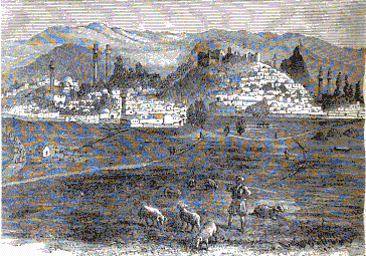
|
Proceedings of the Royal Geographical Society and monthly record ...,
Volume 6 By Royal Geographical Society (Great Britain) - 1884
The Armenians are most numerous in the vilayet of Sivas; but there are large settlements near Isnik, Brusa, and Afiuni Karahissar descended from colonies forcibly planted in those places by the Seljuk and Ottoman Turks. In Angora there is a large Roman Catholic Armenian community, a large proportion of which came from Armenia during the present century. The Armenians present more than one variety of type; and the difference between the Armenian mountaineer of the Taurus and Giaour Dagh and the Armenian of the Anatolian towns on the plateau is most striking. The Armenians carry on much of the commerce of Anatolia, and they are equally successful as large merchants or small pedlars. The extent of some of their operations may be gathered from the fact that one merchant at Sivas sends his agents to Bokhara, Samarcand, and the remotest towns of Central Asia; the men are sometimes away for three or four years, and generally return with a handsome profit on their venture. The system is not unlike that which seems to have prevailed in the Middle Ages, when merchants made long and perilous land journeys which lasted for several years. The Armenians of the Bozuk, as the country round Yuzgat is called, are great camel breeders, and they and the Turkomans breed the fine Tulu camels which are so much admired, by the passing traveller, on the quays at Smyrna. The Tulii is a cross between a Bactrian, two-humped, father and a Syrian mother; he has one hump, like his mother, but in other respects, especially the fine head and abundant beard, follows his father. The Tulu is invaluable in Anatolia as he works in mud and snow, which would soon kill the Syrian camel; he cannot, however, stand great heat, and in summer he is taken off to the plateau, and is replaced on the coast by the Syrian camel. The Armenians often make long journeys to Turkestan or Tiflis in search of good Bactrian stock; and in the breeding season the males are sent round from village to village, as stallions are in this country." |
| Reports from the consuls of the United States By United States. Bureau of Foreign Commerce - 1884
Sivas. — The next important point on the line is Sivas, a city of 40,000 inhabitants. As this city occupies an important strategical position commanding the approaches from the Russian and Persian frontiers, is the center of a very large grain district and is the natural starting point for a branch road to the Black Sea on the north, it will undoubtedly become one of the main points on the line. The trade of the city is entirely in the hands of the Armenians. It consists of hides, grain, rugs, wool, carpets, silver wire work, vegetables dyes, etc. East and northeast of Sivas is an extensive mineral district, the center of which is Kara Hizzar. This region abounds in argentiferous lead, coal, asbestos and, marble. While the road will probably not run directly through this district it will be near enough to it to afford means for transportation of ore, and thus open up resources which are now useless. Continuing southeast from Sivas the route passes Arabkir, a thriving town of 29,000 inhabitants. The people are principally engaged in the manufacture of coarse cotton cloth from English yarn on hand looms. There are probably one thousand looms in use. |
| The Hubbards of Sivas (1870s to 1890s), Edwin W. Martin
Albert and Emma Hubbard were American Protestant missionaries to Sivas from the 1870s to the 1890s. The book, The Hubbards of Sivas, is based on diaries and letters written by Albert and Emma Hubbard to their family in the states and to each other in times of separation. It gives a few glimpses into live in Sivas. Traveling from Constantinople to Sivas in 1873 to 1894
"The next leg of the Hubbard's journey to Sivas took them from Constantinople to Samsoon (Samsun) a Black Sea voyage of about 200 miles. From Samsoon they rode seventy miles by horseback to Marsovan (Mersifon), where there was a substantial mission station and college." From Marsovan it was a further 150 miles by horseback or wagon to Sivas. Sometimes there were roads and sometimes there were none. It took them an additional 7 days of travel to get from Marsovan to Sivas. On the first day they covered 24 miles and stopped in Amasia. They had their own bedding but fleas and bed bugs were a problem; alleviated somewhat by flea powder. From Amasia they traveled 27 miles to find a kahn that was "half stable half other" with one room for all the lodgers, men and women. On day three the group traveled only 16 miles but stopped in a first class kahn which had separated rooms with doors, but no tables and chairs. On day four they covered 28 miles and arrived at Tokat in the mid afternoon where they stopped at the Protestant mission for a few days. The next leg took them 21 miles with no comments about the accommodations. On day six of their traveling they covered 18 miles and stopped at a place where the fleas were so bad and they opted to sleep in the carriage. The last segment was a further 18 miles to Sivas. At another point Albert describes going to the annual meeting in Constantinople as "a considerable journey overland to the Black Sea port of Samsoon followed by a brief sea voyage."In 1877 the journey from Sivas to Samsoon took 10 days. There was no harbor in Samsoon and the ship was reached by a small row boat. The horse and camel communication with Constantinople was open all winder despite heavy snows in the area. There were wild mountains to the southeast of Sivas. In 1894 the road to Constantinople via Cesarea and Angora (Ankara) was longer and "obstructed by quarantine". In 1894 it took Alfred two weeks and a day to get from Sivas to Constantinople. In 1894 Alfred also left for the states aboard a French ship from Constantinople which stopped in Marseilles. From Sivas they sailed eighteen houses to Piraeus, where the ship stopped for two hours. He does not say how long it took form Piraeus to Marseilles. On his return to Sivas he left Constantinople on June 8th and reached Samsoon on the 10 and started overland the same day arriving in Sivas on the 19th of June. Hazards of Travel Robberies were common on the mountain roads of Anatolia. The City of Sivas Sivas was described as, "A somewhat remote provincial capital in the vast Ottoman Empire, hoping that a projected railroad would some day restore its importance as a regional trade center. Still dependent on horse and wagon and oxcart for its trade links with the sea and with Constantinople, the city had changed little of the centuries."Disease There was cholera in Sivas in 1894 for the first time in forty years Earthquake
Turkey was hit with an earth quake in the Constantinople region in July 9 , 1894.
Eating The Armenians ate on a "small round table not more than a foot high, and three or four in diameter." For each person who is to eat put a wooden spoon & a piece of bread on the edge of the table, and a cushion on the floor. The food is one deep dish in the center. Each person ate from the common dish. If there is more than one course they were eaten in succession. The first dish being removed and another put in its place. The last cooked dish to be eaten was pilaf. Stoves are holes in the ground over which are put tables and over the tables are spread large heavy comfortables. Hot coals are put in these holes and gusts who are cold sit down on the floor and tuck hands and feet under comfortables, over coals. This is also their dining table. Roman Catholics in the Area The Jesuits were active in the area. They "spent lots of money" and "were doing everything in their power to draw the people" and were having "apparent success", "They teach free, and feed the poor a great deal". Albert talks of two churches in Sivas, "the Catholic church and the Jesuit's church". 1895-1897 On November 22, 1895 about 1,200 Armenians were killed in Sivas. About four "Mohamendas" were also killed. America State Department Consul Jewett wrote: " Turks tell me that the massacre and pillage here were under the management of the mayor of the city and other officials and prominent Turks. They say the money saves were taken in storage by the Chief of the Gendarmes and his men who opened them and divided the spoils. Now those most responsible for the outrage are constituted by the governor into commission to investigate and reestablish peace and friendship. Not a Mohammedan has been arrested. There is no officer to make the arrests who is not himself one of the most guilty parties. Officers tell me that there is not an Armenian village left unruined in this part of the country except one that the Governor protects and another which is a Catholic village, and it is well-known the Catholic Patriarch has been courting the favor of the Sultan."He also alleges that the Moslems were trying to convert the Armenians, to force their men to be circumcised, and were raping or carrying off the young women. In 1896 there were continual reports of massacres and the Armenians were "afraid to move or be seen" and were living in terror. Alfred added that the Consul thought that "the gov't is doing its best to prevent such things here". On a trip to Egin to escort a female missionary to Sivas Alfred spent several nights on the road talking to Kurds about the destruction of the Armenian villages in the area. He obtained the following information about the massacres: Arabkir, of "4,000 Armenian houses only 300 were left unburnt".The unrest continued in 1897 when in March of that year the stores were closed and the people in Sivas were "in terror" for two weeks. Some of the surrounding villages were attacked including Tokat where 400 were killed and most of the village looted. Bighan does no have much to say about the physical aspects of Sivas or about the local people except the Europeans and the officials.
|
|
Information supplied by the American
Missionaries to General Sir C. Wilson and forwarded by him to Sir H. Yule.
"One of the oldest churches in Sivas is St. George (Sourp-Kevork), occupied by the Greeks, but claimed by the Armenians; it is situated near the centre of the town, in what is called the "Black Earth," the spot where Timur is said to have massacred the garrison. A few steps north of St. George is the Church of St. Blasius, occupied by the Roman Catholic Armenians. The tomb of St. Blasius, however, is shown in another part of the town, near the citadel mount, and the ruins of a very beautiful Seljukian Medresseh."Armenian Apostolic Churches in Sivas Apostolic: Holy Virgin, St Sergis, St Minae, St. Savior. Note: These are not the same listed by Robert Hewsen, see below. Roman Catholic Church: St. Blasius
|
|
Supplementary papers, Volume 3 By Royal Geographical Society (Great Britain), 1893
PART III1 Pelkinik =Pirkinik | |
|
Across Asia on A Bicycle, Century Magazine, May 1894
"The comparative size and prosperity of Sivas, in the midst of rather barren surroundings, are explained by the fact that it lies at the converging point of the chief caravan routes between Euxine, Euphrates, and Mediterranean. Besides being the capital of Ruminli, the former Seljuk province of Cappadocia, it is the place of residence for a French and American consular representative, and an agent of the Russian government for the collection of the war indemnity, stipulated in the treaty of '78."Note: The Black Sea was known as the Euxine Sea in the antiquity.
A Ride Through Western Asia, Clive Bigham, 1897 In 1897 Sivas was divided into different quarters; Turkish, Armenian, and Circassian. The road from Angora (Ankanra) to Sivas "is as bad as it can be — in some places a mere track over the rocks. We hired a common county cart call and "araba" furnished with a hood, to carry the luggage. The price as far as Sivas (290) miles was £4 pounds 15 s."Bighham road on horseback while his guide wrote on the supply cart. They bought red wine as the water was not drinkable due to cholera. They also brought bread, rice, potatoes and cooking oil but no meat as it was too hot to store it. They bought chickens and eggs along the way the way. They started on July 25 for Sivas. They had to cross the hot plains between Angora and Sivas. The heat was the most intense Bigham had ever experienced. Meat was difficult to get; fruit dangerous. There were no vegetables except cucumbers. Eggs and chickens were cheap. Bigham consistently described the Armenians as dirty and unwashed; afraid of water. Along the way they met some Armenians traveling in wagons dressed "in semi-European clothes" who told them they were traveling to Angora for purposes of trade. The Armenians were not allowed to carry weapons so they traveled in large numbers for protection.
"The Kurds are in general far more attractive to the casual observer than the Armenians. In spite of their brigand lives they are more honest and straightforward, and they bear pain with remarkable fortitude. They probably suffer as much, if not more, at the hands of the Government, but their plaints do not reach so far."It took them nine days to travel the 290 miles between Angora and Sivas.
|
|
|
|
Message from the President ... transmitting, in response to the resolution ... By United States. Dept. of State
1902
SIVAS, TURKEY |
|
|
|
Money, Land and Trade: An
Economic History of the Muslim Mediterranean By Nelly
Chapter 8*
The Private Papers of an Armenian Merchant Family in the Ottoman Empire 1912-14
By
Armin Kredian
"The Armenian townspeople in the vilayet of Sivas were engaged mainly imprinting cotton hangings, painting and dying, textile weaving, sewing, belt making, carpet making, shoe making, and watch reparing; they also worked as blacksmiths, carpenters and Masons." |
|
The American Catholic quarterly review,
Volume 42 edited by James Andrew Corcoran, Patrick John Ryan,
Edmond Francis Prendergast - 1917
At Sivas, which was the birthplace of Mekitar, there is the monastery of St. Nishan, in which the Bishop of Sivas resides. This monastery was founded in the thirteenth century. It is described as spotlessly clean, cleanliness being an Armenian virtue, but it is very bare; the walls are covered with plain hangings; heavy, paddedleather curtains take the place of doors to the cells and the woodwork is unpainted; the whole place is warmed only by charcoal braziers.Written by Darley Dale. Sources: Childs, W. J. - "Across Asia Minor on Foot." 1917. Buxton. Noel & Harold - "Travels and Politics in Armenia." 1914. Hogarth. D. G. - "The Nearer East." 1905. |
|
Ottoman Manufacturing in the Age of the Industrial
Revolution By Donald Quataert, 1993
Until 1890 Sivas rugs were made in the small villages in the countryside around Sivas. In 1890 the government established 300 looms in the city of Sivas itself. These rugs were of different design and contained more knots per square inch that the country rugs. By 1902 there were 2,000 looms in the city. In 1911, in addition rugs being made on home looms, rug factories employed thousands of "little Armenian girls". 350 villages in the state of Sivas had about 10,000 looms. |
|
Greenmantle, John Buchan, 1916
Greenmantle is an adventure and espionage story set in Turkey during WW I with four English spies who travel from Constantinople through Ankara and on to the Russ-Turkish border to Erzerum. From Chapter Sixteen, The Battered Caravaseai "About midday we descended on a wide plain full of the marks of rich cultivation. Villages became frequent, and the land was studded with olive groves and scarred with water furrows. From what I remembered of the map I judged that we were coming to that champagne country near Siwas, which is the granary of Turkey, and the home of the true Osmanli stock."Note: Siwas=Sivas
|
|
Crossing Asia Minor, The Country Of The New Turkish Republic,
Major Robert Whitney Imbrie, National Geographic, 1924
In 1924 Angora (Ankara), the new capital of Turkey had no sewage system, no sidewalks, and no streetlights. It can be assumed the same was true for Sivas. There were no hotels in all of Anatolia in 1924. Travelers stayed in the Khan. A type of oriental inn, the khan was an enclosed courtyard surrounded by a wall (mud or wood). On at least one side there was a two-story structure. The lower story contained stables. The upper story had rooms for guests. However many guests camped in the courtyard. The guest was obliged to provide all of his/her necessities: food, bedding, drink. Hygiene was almost completely lacking and the Khan was full of bugs. Most western travels only stayed in the Khan for protection from bandits. Sivas is about 200 miles due east across the Mysian plateau from Ankara. Imbrie describes the trip from Ankara to Sivas as "over parched and dreary country with little to relieve the eye" and "Lonely open country with out much water". Two days out from Kaisariye near Shehr Kishla the country began to change. "Occasionally we would cross a small stream bordered by cottonwood trees.Out of Shehr Kishla towards Sivas: "We rode through a land forlorn, between bare hills and with never a tree in sight.About Sivas: " Through Sivas passes the Great Road of Asia Minor, the road over which for centuries the caravans from Bagdad to Istanbul have passed. Though it has now fallen into complete disrepair, it is still enormously important as a trade route from the Black Sea to the interior. It was over this road we headed for the Black Sea and Samsun, 200 miles away." |
| Note: I bought the above article on eBay and the seller did not include an
issue number or month; just the year. The article was prefaced by the following: "The following article, descriptive of a journey made by the author when a special representative of the American State Department in Angora, formed the basis of a lecture before the National Geographic Society in Washington in January 1924, and was probably Major Imbrie's last literary project. It is a significant fact that he here emphasizes a sympathy and an understanding of their philosophy, their customs and their prejudices. Major Imbrie's tragic death in July at the hands of an unprovoked mob in Teheran, the capital city of Persia, where he was the American vice-consul, is a great loss to the Foreign Service of the United States. He was an American gentleman- honorable, considerate, and brave. He served his country gallantly on the field of battle and in important diplomatic mission. THE EDITOR."Robert Whitney Imbrie was beaten to death by a mob in Teheran. He was buried at Arlington National Cemetery. To see articles about his murder and view a photo of his head stone go to Arlington National Cemetery, Robert Whitney Imbrie
|
|
|
|
Armenia Sebastia/Sivas and Lesser Armenia edited by Richard G Hovannisian, 2004 (UCLA Armenian
History and Culture Series)
Armenian Sebastia/Sivas and Lesser Armenia Richard G Hovannisian Before modern transportation Sivas was at least a six day journey from Constantinople. The Caravan route bridge across the Halys River east of Sebastia bore an Armenian inscription which was still visible in 1998.* Many of the Armenians who were in Sebastian until WWI were descendants from the original Armenian population of the area. Others however had arrived in Sivas from the east during the Armeno-Byzantine period. "The Armenians never forgot the saga of the arrival of their kings in Lesser Armenia, whose relics were shown in the local monasteries, and, however dubious, from whom a number of prominent Armenian families of Sebastia even claimed descent." The Ottoman Census of 1914 showed 3,693 Armenian Catholics. The Catholic bishopric was established in Sivas in 1858. "There was also a Roman Catholic Jesuit school (college) actually more of a preparatory school for students in tending to enter institutions of higher learning elsewhere." * We did not see an Armenian inscription on the bridge when we visited in 2008. Armenia on the Halys River, Robert H Hewsen, Armenia Sebastia/Sivas and Lesser Armenia edited by Richard G Hovannisian In the town of Sivas the Armenians were the merchants, traders, grocers, artisans and involved in money changing and lending. Sivas was something of a cultural backwater until 1908.
"The city of Sivas lies at an altitude of 1,275 meters (4,183 feet) above sea level somewhat north of the right bank of the Kizil Irmak. Besides the Cathedral of Surb Astvatsatin (built in 1840), the Apostolic Armenians possessed three other churches; Surb Hakob, Surb Prkich, and Surb Sargis. There were also and Armenian Catholic Church, and Armentian Protestant Church, a Greek Orthodox Church, and a Catholic chapel attached to the Jesuit mission in the city. In addition, Sivas had an Armenian hospital, and American mission, and American mission hospital and a Swiss orphanage." In the first Turkish census of the Turkish republic in 1927 there were 30,000 people in Sivas. Armenian Sebastia ended in 1915 but there were said to be some 300 still living there in the 1970s.* One of the parks in Sivas is adorned with old tombstones including some with Armenian inscriptions.** About 2 kilometers from Sebastia lay the monastery of the Holy Cross (Surb Nsham or Nisan) built before the 11 century (perhaps earlier). The throne of the Artaruni kings were preserved there.*** *On our visit in May 2008 we were told by our Armenian contact in Sivas that there were 76 Armenians (forming part of 20 families) still living in the city of Sivas. According to an interview of the Patriarch Mesrob II of Istanbul and Turkey by Florence Avakian in 1999, there were 40 families living in Sivas and speaking Armenian with a Sebastian dielact. This number of families may reflect the number in the state of Sivas and not just the city of Sivas. **On our visit in May 2008 we did not succeed in finding such a park. ***According to our Armenain contact in Sivas, the ruins of this monastery were razed in 1978. Armenian Immigration to the Sebastian Region, Tenth-Eleventh Centuries, S. Peter Cowe The Bagratuni/Bagratid Dynasty, one of the two most important Armenian princely and royal houses, arrived in the Sivas area in the 10th century.
Armenian Art and Architecture of Sebastia, Christina Maraci Most of the Armenain churches and monasteries have be altered beyond recognition or razed to the ground*. Maraci says that the Monastery of the Holy Cross was destroyed completely in the 1980s. Sabastia was an important center of Armenian scriptoria during the late Middle Ages. There are Armenian manuscripts from the Monestary of the Holy Cross, Sivas at:
* Our Armenian source in Sivas, at the time of our visit in May 2008, said that there are no remains of any of the Armenian churches in the city of Sivas. We were shown two ruins of Armenian churches outside of the city.
A Farewell to the Armenains of Evdokia/Tokat, Barlow Der Mugrdechian
"Several waves of immigration added to the Armenian element, most notably during the first part of the eleventh century, when King Senekerim-Hovannes Artsruni of Van/Vasourakan relocated with a large retinue, estimated to by 14,00 cavalry and their families, to Sebastia and the neighboring areas."There continued to be migrations to Tokat over the centuries for various reasons, war famine etc, in the east which pushed the population west. The same must have been true for Sivas. Jesuits were the first Catholic missionaries to arrive in the area in the early 17th century. They were followed by the Capuchins. The numbers of Catholics increased although only a few Armenian clergy were converted. The Ottoman Empire recognized the Armenian Catholic millet (congregational community) in 1830. In those towns were the Catholic population was small and did not have many churches they were compelled to maintain ties with the Apostolic church and most of the rites of baptism, marriage and death were performed in the Apostolic church. Mass and communion were celebrated in private homes. Tokat was 12 to days journey from Consatntinople and was on an ancient silk road from Erserum. (From todays map it looks like this route would bypass Sivas.) By the early 1800s the khans were empty and there was little economic life in Tokat.
Rural Sebastia The Village of Guvdin, Murad A Meneshian The area around Sivas contained a number of Armenian villages. Most of the Armenians in these villages farmed the land and tended livestock. An example of one of the larger villages in the area was Govdun. Situated 12 miles east of Sivas it consisted of about 300 households with nearly 3,000 inhabitants. The village was supposed to have been settled by members of the retinue of Kiing Hovhannes-Senekerim Artsruni. On Easter eve everyone dressed in the best attire and went to church. Hardly had the priest uttered the words, "Take this bread and eat...." then many men and boys ended the fast and challenged one another to see whose red colored egg was the strongest when struck against the tip of another." During the following days there were may "egg fights" (Armenian Sebastia/Sivas and Lesser Armenia, editeded by Richard G Hovannisian.)* Villages were isolated from one another because of the poor road conditions and a large gap existed between town and village and there was the usual distrust of one for the other.
Govdun (Kovton) still exists as a Turkish village called Göydūn north of the Halys River a few miles east of Sivas. See Govdun
*My husband's mother, Alice Azarian, was Armenian. She and her sisters continued the tradition of egg fights after they immigrated to the USA. Taniel Varoujan Taniel Varoujan, the great Armenian poet, was born in 1884 in the village of Brgnik (Prknig) to Krikor and Takouhi Varoujan. The family remained in Pirkinik for twelve years and then moved to Constantinople in 1896 where Krigor was a migrant worker. He attended the Armenian Catholic Mekhitarist School in Constantinople until 1902 when he left for Venice. He was the principle of Saint Gregory the Illuminator (Grigor Lusavorich) in Pera from 1912 to 1915. He married Araxie and had a daughter, Veronica Jaroujan Safrasian. | |
| | |
| Earthquake in Sivas February 1909 "A number of houses and government buildings at Sivas, the capital of a vilayet of the same name in Asiatic Turkey, collapsed Tuesday as the result of an earthquake." Jefferson County Republican, Fairfield, Iowa The 6.3 quake occurred February 9, 1909 and a 101 lives were reportedly lost. Major damage was done with over 400 buildings destroyed. The city's population was said to be 43,000. There were multiple shocks. The first shock greatly weakened many buildings and the second shock came with terrible force. Three local villages were covered by mountain slides. | |
| | |
| The Armenian Population of Sivas After 1915 CHANGE AND CONTINUITY IN THE SIVAS PROVINCE, 1908-1918 A THESIS SUBMITTED TO THE GRADUATE SCHOOL OF SOCIAL SCIENCES OF MIDDLE EAST TECHNICAL UNIVERSITY BY DENIZ DOOLEK, 2007 and available online at CHANGE AND CONTINUITY IN THE SIIVAS PROVINCE, 1908-1918 maintains that Sivas was the largest and most populated Anatolian province and also contained the largest Armenian and Greek populations among the provinces. Doolek asserts that the disturbances in the area prior to 1900 were caused by animosity between the Armenians and the Kurds. He states that the Armenians started to leave the province in the late 1890s. "According to a report sent by Vice-Consul Bulman from Sivas in August 1896, two hundred and ninety three Armenians obtained teskerehs, official travel certificate, and left the country individually (leaving their families behind). Most of them went to Russia or America. Forty seven families left for Smyrna and Istanbul. In addition, one hundred and fifty men left, without teskerehs, for Zeytun, Samsun, Trabzon and Ankara. Finally, four families departed without teskerehs by planning their escape at the coast. It is obvious that, the Armenians left the province with teskerehs preferred to live in more secure regions. However, those leaving without teskerehs and going to more dangerous areas inspires the idea that they were engaged in militant activities."He says: "despite the rising tensions between the Muslims and Armenians since the 1890s, events never took the form of an ethnic conflict in the Sivas Province." Deportation of Armenians from Sivas Province started in June 1915 and ended in March 1916. Armenians were allowed to return in 1918. A few returned but most did not stay. Their houses and land had been allotted to Muslim refugees. "a letter, sent to Ministry of Interior by four Catholic Armenians from Pirkinik, a village of Sivas, indicated the existence of some property problems. According to this letter, forty Armenians returned to Pirkinik; however, the local government in the Sivas Province did not restore their lands and houses. As a result, the Ministry of Interior sent a document to the Sivas Province on 19 January 1919 and demanded the investigation of this situation quickly. It stated that if there were occupied houses and lands by Muslims they should be restored to their original owners." | |
| | |
| Illness | |
| Plague and smallpox were rampant in the villages near Sivas in 1841.
| |
| Henry S. West Henry S. West was born in Binghamton, New York in 1827. He graduated Yale in 1844 and the college of Physicians and Surgeons in 1850. In 1858 he became a missionary to Turkey. He and his wife were stationed in Sivas. He contacted typhus fever and subsequently pneumonia and died in Sivas in 1876. Extracts from letters received from Henry S. West, M. D., Physician to the American Board for Foreign Missions, at Sivas, Syria - 1865 [Communicated by Dr. J. G. Okton, from Committce on Correspondence for the Sixth District.]Among the surgeries Dr. West performed over a period of five years were:
Boston medical and surgical journal, Volume 131 By Massachusetts Medical Society, New England Surgical Society, 1894
SOME EXPERIENCES WITH ASIATIC CHOLERA IN ASIA. | |
| | |
| Maps | |
| | |
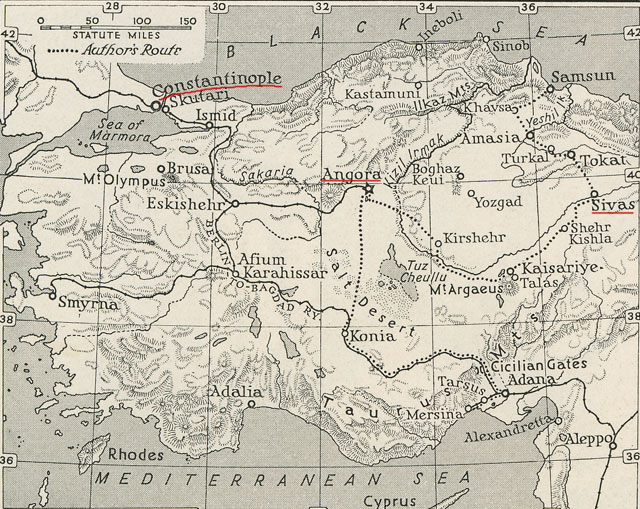 | |
|
A Sketch Map of Asai Minor (Anatolia) National Geographic 1924.
This map shows the possible routes from Sivas to Constantinople.
| |
| | |
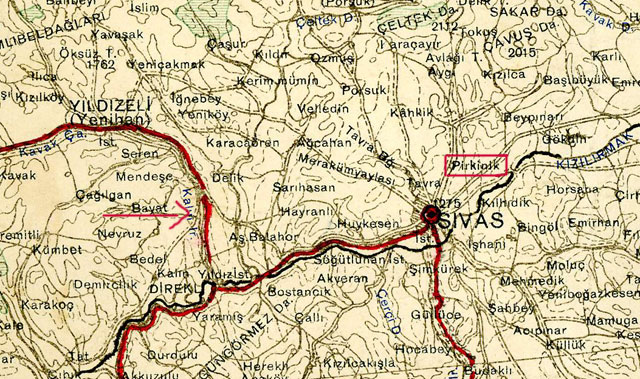 |
|
Map collection of Maggie Land Blanck
Map of Sivas showing Pirkinik
|
| | |
|
Dick Osserman's photos of Turkey Dick Osserman has taken some wonderful pictures of Turkey which can be seen on his web site at Dick Osserman His pictures of Sivas are at Dick Osserman, Sivas Turkey
Sivas 1877 : Sivas Marhasaligi ve Sivas Vilayetine Bagli Birkac Onemli Sehir Hakkinda Rapor (Sivas, Tokat, Amasya, Merzifon) by Bogos Natanyan, Edited by Arsen Yarman is available on line at abebooks.com . Unfortunately, for me, it is in Turkish. However, it contains many images of Armenian Sivas. In 2008 Arsen Yamen was kind enough to write that he liked my Sivas page. He clarified a misunderstanding I had about the author of the book; "The book that Natanyan wrote is only a part of Sivas 1877. The whole book is 560 page, Natanyan's book is only 230 pages (in originally it is 130 pages). We translated Natanyan's original 130 pages and added a lot of photographes, documents etc. | |
| | |
|
Armenian Church in Kayseri In August 2009 I got an email from Gary Malkhassian whose family was from Kayseri. He shared some images of the the Armenian church in Kayseri. Kayseri is another Antolian city that once had a large Armenian population. The church of St Gregory the Illuminator in Kayseri is the last standing Armenian church in Anatolia. It is impossible for me to say (with the information I have available at this time) how it may have compared with the churches in Sivas. However, one may assume that a relatively rich city like Sivas would have has a similar structure. The link Gary sent me does not exist as of January 2011. But you can find images of the church by doing a google image search. | |
 | |
| Collection of Maggie Land Blanck | |
| | |
 | |
| Collection of Maggie Land Blanck Divik Demirdagin umumi gorunusu Divik (Divrigi) 93 miles SE of Sivas was a stop along the caravan route from Sivas to the Euphrates valley. |
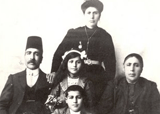 |
The Abkarian Family of Sivas Click on Image |
| Lucy | |
| Pirkinik | |
| Arevian/Hagopian | |
| Other Azarians | |
| Images of Armenian Life in Turkey | |
| The Genocide | |
| Connection to other related pages | |
| If you have any suggestions, corrections, information, copies of documents, or photos that you would like to share with this page, please contact me at maggie@maggieblanck.com |
|
Please feel free to link to this web page. You may use images on this web page provided that you give proper acknowledgement to this web page and include the same acknowledgments that I have made to the provenance of the image. Please be judicious. Please don't use all the images. You may quote my original text from this web page and use any cited quotes on this web page provided you give proper acknowledgement to this web page and include the same acknowledgments that I have made to the provenance of the information. Please do not cut and paste the whole page. You may NOT make use any of the images or information on this web page for your personal profit. You may NOT claim any content of this web page as your original idea. Thanks, Maggie |
| © Maggie Land Blanck - Page created 2004 - Latest update, August 2019 |